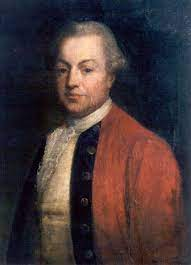S.W. O'Connell's Blog, page 6
December 30, 2021
Hart of the Rebellion
The role of women in the American Revolution is understated and underappreciated. Patriot women were there - whether it was to provide moral and physical support, maintain the family farm or business, spying, or actual fighting. They wove desperately needed clothing for the half-naked American soldiers. They provided foodstuffs to starving columns that passed through towns and farms. And during an eight-year struggle, patriotic mothers sent many a young man or boy to the ranks. In addition to yearning and fighting for liberty, every American soldier yearned to return to their home, family, and wife. One could say these women were the heart of the rebellion.
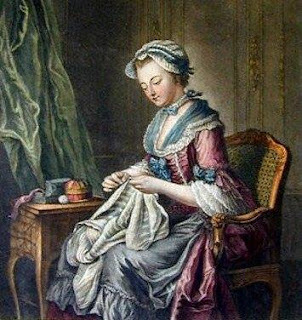 The distaff side was critical to the war effort.
The distaff side was critical to the war effort.
Ann Hart is one such woman. Born Ann Morgan in 1735, the exact date is unknown. Nor is the exact location, although it is believed somewhere in Pennsylvania or North Carolina.
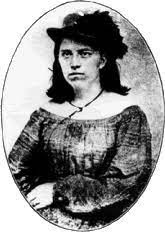 Ann Morgan Hart
Ann Morgan Hart
Names were tricky back then, and the use of diminutives was widespread. Ann Hart was no exception, sporting the handle "Nancy," a common nickname for Ann at the time. According to accounts by contemporaries, Nancy was an imposing figure over six feet tall, well limbed, and red-headed. She was known for her fearlessness; the local Cherokees even called her Wahatche (war woman).
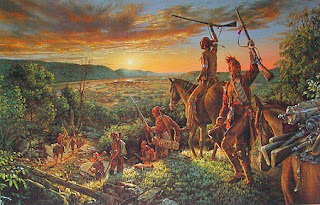 The Cherokee called her War Woman
The Cherokee called her War Woman
By the run-up to the War for Independence, Ann Morgan had married Benjamin Hart, and the couple settled along the Broad River in Wilkes County, Georgia, where land was fertile, cheap, and available. The year was 1771. Ann was relatively old when they married – thirty-six. Despite that, she gave birth to two daughters and six sons.
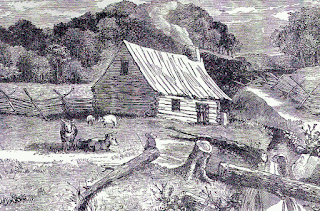 The cabin on the Broad River
The cabin on the Broad River
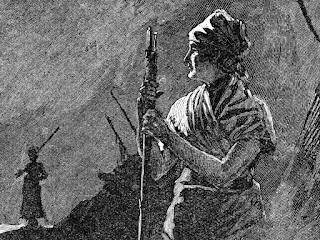 Nancy was a resourceful backcountry woman
Nancy was a resourceful backcountry womanAs rumor and legend will bump up against known facts, I should say Ann is said to be a relative of famed explorer Daniel Boone. And she was a cousin to Daniel Morgan, famed leader of the corps of Virginia and Pennsylvania riflemen and victor of the Battle of the Cowpens (1781).
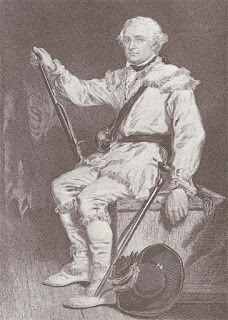 Colonel Dan Morgan
Colonel Dan Morgan
After they moved to Georgia, Benjamin joined a Georgian militia regiment. Nancy would also become a staunch patriot and wage her own war against Georgia Loyalists.
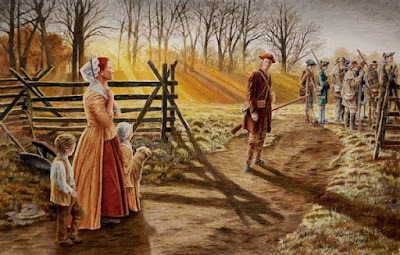 Benjamin joined the Georgia militia
Benjamin joined the Georgia militia
Nancy was feisty and quick-tempered, according to accounts. And she ran the Hart household with an iron will and an iron fist. So, when Benjamin Hart went off to follow drum, Nancy was the perfect woman to "hold the fort." Ironically, the drum soon would follow her.
The British retook the breakaway colony of Georgia in 1779 as the launching pad of their "Southern Strategy." British occupation did not always mean British control, especially in the northeast backcountry of Georgia, where locals had been squaring off with the Cherokee for years. The American struggle for independence was also a civil war, and unlike the 18th-century wars in Europe, civilians played a role throughout.
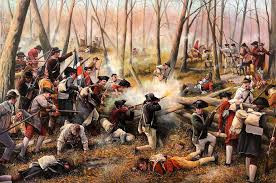 Battle of Kettle Creek by Jeff Trexler
Battle of Kettle Creek by Jeff TrexlerAccording to reports from both first and second sources, Nancy was variously a spy against the British forces in the area, a sniper of the same (she was reputed to be a crack shot), and an occasional combatant. Because of her size, it would have been easy for Nancy to dress in men's clothing and slip into British camps, as is alleged. Pretending to be crazy, she would observe activities and listen to conversations before slipping away and reporting back to local patriot militia leaders.
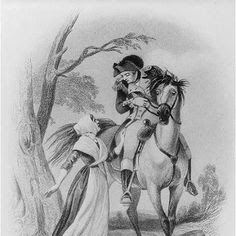 Spying on British
Spying on British
Also reputed to be a sniper, she may have taken long-distance shots at Loyalist and British patrols, couriers, and convoys trying to cross the Broad River. The war in the south had turned vicious, and sniping and ambush so frowned on in 18th-century warfare became common in the Carolinas and Georgia.
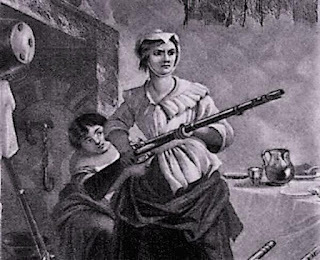 Lady sniper
Lady sniper
The British and their supporters must have suspected the strange woman because they took pains to keep their eyes on her activities, often coming by the farm to get food or check up on things. In one incident, Nancy was making soap in their cabin when one of her daughters discovered a Loyalist spying on them through a crack in the wall. When she told Nancy, the fiery redhead threw a ladle of the boiling lye through the gap, burning his eyes. As he howled in pain, the angry farm woman raced out, overpowered him, and tied him up. She eventually turned him over to the local patriot militia.
An account has Nancy carrying grain to the local mill when a gang of cowboys (Loyalist raiders) pulled her from the saddle and tossed her to the earth. As they made off with her horse, Nancy dusted off the dirt and carried her heavy grain bag to the mill on foot.
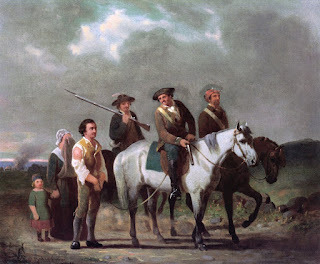 Cowboys terrorized patriot homesteads
Cowboys terrorized patriot homesteads
Some accounts put our southern hellfire at the 1779 Battle of Kettle Creek, but that is pure speculation. But the most famous of her exploits seems right on target. A half-dozen Loyalist militiamen showed up at her farm, stopping for food while pursuing a rebel. They insisted Nancy prepare a turkey. Since they were armed and ready to mete out punishment on a patriot wife, she had no choice but to submit to their demand.
But the Loyalists made one big mistake. They neatly stacked their muskets near the door when they entered the cabin to sit at the dinner table. Nancy went to work with the table set and the food going down in mouthfuls. She slipped some of the muskets through a hole in the cabin wall. Nancy kept the food and drink coming, and once the men were sufficiently lubricated, she seized one of the muskets she left in the cabin and leveled the barrel on her visitors.
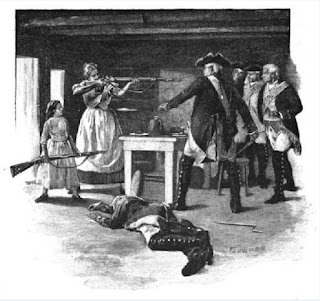 Turning muskets on the Loyalists
Turning muskets on the Loyalists
Glaring at them with a Brown Bess at full cock, she ordered them not to move. Refusing to be taken by a woman (and under the influence), one Loyalist made a move on her. That's all it took. Nancy squeezed the trigger, and the hammer slammed into the pan, striking the powder and sending a plug of lead into his chest. Another Loyalist lunged at her, but Nancy had grabbed another musket and blasted him. She had little trouble convincing the remainder to sit quietly at the table until help arrived. When her neighbors and husband appeared, they decided to shoot the prisoners. But Nancy refused. Instead, she demanded they be hung from a nearby tree.
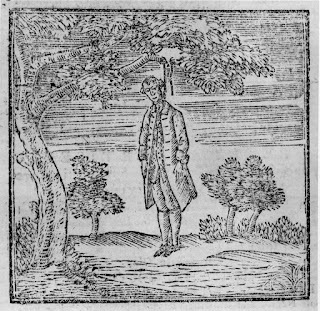 Nancy demanded the Loyalists be hanged
Nancy demanded the Loyalists be hanged
This tale was corroborated in the early 19th century uncovered the remains of a half dozen men were dug up at the farm – four with broken necks.
Like so many Americans, the post-war period was one of transition and movement. In the late 1790s, Nancy and her husband moved the family to Brunswick, Georgia. When Benjamin died there in 1800, Nancy decided to return to her former home on the Broad River. Unfortunately, their cabin had been washed away by a flood.
With the farmhouse gone, she moved in with one of her sons, John Hart, and his family along the Oconee River in Clarke County near Athens, Georgia. In 1803, Nancy moved with John and his family to Henderson County, Kentucky, to live near relatives. The fighting lady spent the remainder of her life in Henderson. When she died in 1830 at 93, they buried Nancy in the family plot.
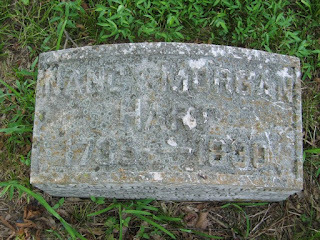 Nancy's gravestone
Nancy's gravestone
Our "Hart of the South" was commemorated by the state she fought so hard to help liberate. A Georgia highway, city, lake, and county are named after her. And the Daughters of the American Revolution recognized this fighting lady by erecting a replica of her cabin on the Broad River using some of the original stones.
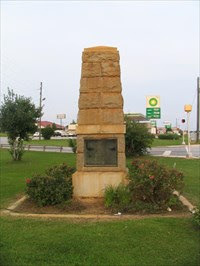 Nancy Hart Monument, Hart Co.,GA
Nancy Hart Monument, Hart Co.,GA
November 30, 2021
The Fighting Fraser
This is the second installment profiling one of the characters in book four of the Yankee Doodle Spies series, The North Spy. due for release next year. As my last profile was a Scotsman who fought for America, it was only fitting that I follow with a Scotsman who fought for England. Not just any Scotsman, but a son of the famed Fraser clan of Highland warriors.
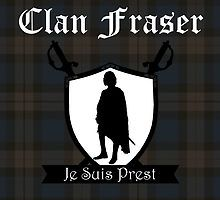
Proud Lineage
Simon Fraser was born into a proud Scots highland lineage at Balnain, Scotland on 26 May 1729. His family and clan were warriors of the first order and as such, many went down at the fateful Battle of Culloden in 1745. Those who did not fall saw their lands and patrimony stripped and were driven into exile.
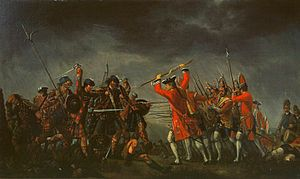 Culloden smashed the Clans - but not the Highland spirit
Culloden smashed the Clans - but not the Highland spiritDutch Service
The Scots, like their cousins across the Irish Sea, tend to fight for the English when not actually fighting against them. This the young Fraser did, but beginning with a stint in one of the Scots Brigades in the hire of the Netherlands - the 4th Brigade to be precise. In the waning years of the War of Austrian Succession young Simon fought at the 1747 siege of Bergen-op-Zoom. The attacking French swarmed over the defense works and streamed into the town where savage fighting took place. In the attack and counterattack, Fraser was wounded.
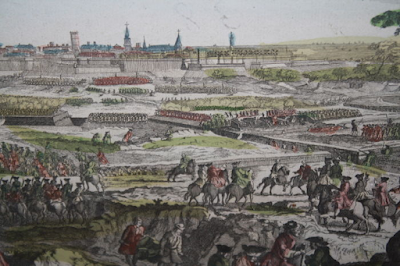 Seige of Bergen-Op-Zoom
Seige of Bergen-Op-ZoomRoyal American
With the end of the war, the Dutch Brigade was reduced to one battalion and Fraser had to seek his laurels elsewhere. The outbreak of the Seven Years war provided a golden opportunity for an eager and now blooded young highlander. In 1756, Fraser joined the British Army’s 62nd Royal American Regiment of Foot. Renumbered as the 60th the following year, it later gained fame as The King’s Royal Rifle Corps.
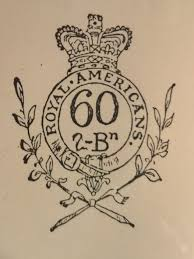
Back to the Clan
Fraser did not remain with the 60th very long. In January 1757, he took a commission in a newly formed regiment of highlanders, the 63rd Highlander Regiment of Foot. The regiment was commanded by Simon’s cousin, Lord Lovat, also named Simon Fraser. The unit was called Fraser’s Regiment and its ranks were flush with Frasers. This was the likely draw to the unit – fighting with and for kin.
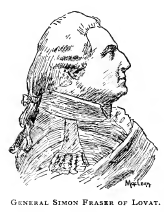
Fighting French & Indians
Fraser sailed to America to fight the French, serving at the siege of Louisbourg, the taking of which gave Britain control of the mouth of the Saint Lawrence River. He served under British General James Wolfe during the 1759 attack on Quebec, the decisive battle of the war in America. The 78th climbed the Heights of Abraham with Wolfe and Lieutenant Fraser was wounded in the hard-fought action while Wolfe was mortally wounded in his great victory.
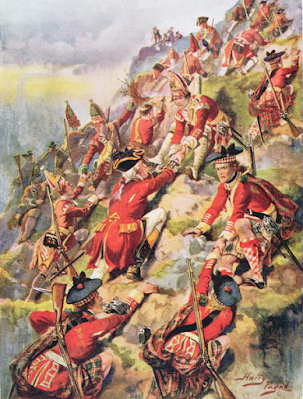 Scaling the Heights of Abraham
Scaling the Heights of AbrahamFraser’s time with the 60th and his service in America with the 78th opened his eyes to the different style of fighting in a woodland wilderness – the need for disciplined troops who could fight outside of massed formations and rely on the terrain and marksmanship to bring down an enemy as the Indian allies of the French could. Following Quebec, Fraser’s unit had garrison duty in the city and spent some time in New York. But the French and Indian part of the war was just about over.
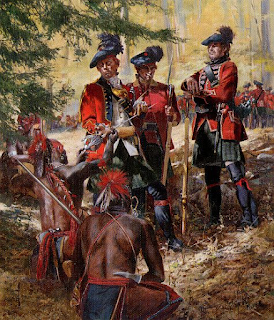 Fraser's Highlanders mingle with Iroquois Braves
Fraser's Highlanders mingle with Iroquois BravesSeven Year Itch
By 1760 Fraser was back in Europe – the seven years of the Seven Years War was not up. This involved another transfer – this time to the 24th Regiment of Foot, which was sent to Germany to serve in Lord Granby’s Corps. In two years, the 24th fought in over a half-dozen sieges and pitched battles against the French. He was cited for heroism at the battle of Wezen in November 1761. Fraser led a hand-picked company of fifty men in an attack that drove off some 400 French troops. He was promoted to major during this time. He also learned a lesson in what hand-picked and specially trained men could do against greater odds.
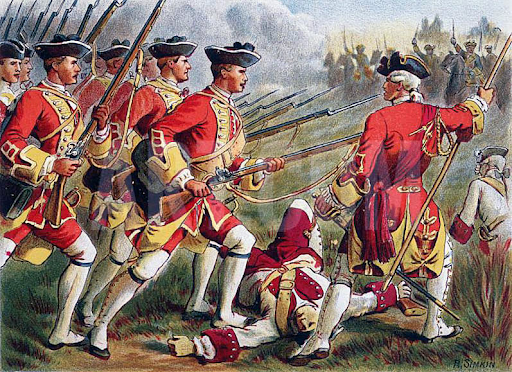 British infantry in the Seven Years War
British infantry in the Seven Years WarPost-Treaty of Paris
After the Treaty of Paris was signed in 1763, Fraser continued with the army – serving in Germany, Ireland, and Gibraltar. From 1763 to 1769, Simon Fraser and the 24th were stationed at Gibraltar. He performed quite well and was appointed Lieutenant Colonel of the 24th in 1768. Fraser put the regiment through specialized training, making it one of the first British regiments to specialize in light infantry tactics.
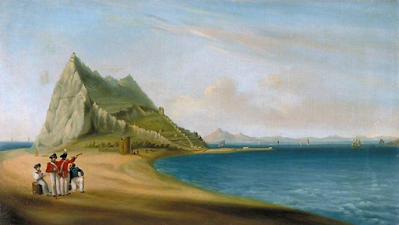 Gibraltar
GibraltarIt was also on Gibraltar that he met Margarita Hendrika Beck Grant, widow of Major Alexander Grant, a fellow Scot. After a period of exchanging letters, they were married. Shortly thereafter, they moved to Ireland when the 24th was transferred there. The couple had no children.
Brigadier General Simon Fraser
War Clouds in AmericaFraser had watched the North American colonies move into rebellion and war. The rebels drove a British Army from Boston in 1775 and invaded Canada. More troops were needed to put down the rebellion. More importantly, Britain needed experienced officers. So it was as commander of a brigade of five battalions Fraser sailed from Ireland and returned to North America in April 1776. He was sent to provide support to the beleaguered Governor-General Guy Carleton who was besieged in Quebec by the American rebels. Carleton had held off the invading army against all odds during a brutal winter campaign. Fraser’s arrival enabled him to go on the offensive.
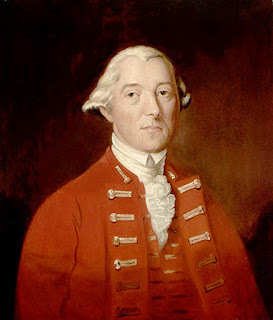 Governor-General Guy CarletonIn the Vanguard
Governor-General Guy CarletonIn the VanguardFraser wasted no time – he smashed American General William Thompson’s division at Trois Rivieres in June. Named brevet Brigadier General by Carleton, Fraser took command of the Advance Guard of the British counteroffensive into New York’s Champlain Valley. Although Carleton’s campaign proved successful, the stubborn American defense, led by Brigadier General Benedict Arnold took him off his timetable by fighting him at Valcour Island. The battle was won but winter was coming.
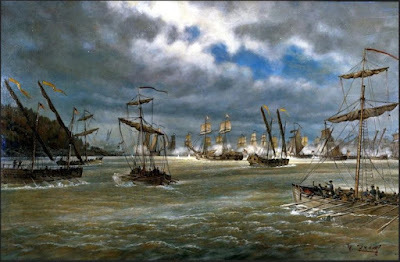 Valcour IslandAn Unsavory Pause
Valcour IslandAn Unsavory PauseRather than risk the final plunge to Albany with winter approaching, Carleton withdrew to the northern extreme of Lake Champlain, planning to strike out again the following year. Fraser, like many other officers, was not happy with the cautious approach but things would have to wait for a new season – and a new commander. Fraser used the winter quarters to train his troops in light infantry tactics and prepare them for operations in the rough American wilderness.
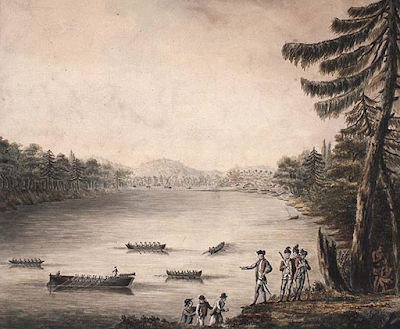 The upper end of Lake Champlain
The upper end of Lake ChamplainNew Boss, New Plan
In the spring of 1777, Major General John Burgoyne returned from London with 8,000 British and German reinforcements and a new plan for invasion. The plan called for three separate thrusts from the west, north, and south to converge on Albany. And the plan called for Burgoyne, not Carleton to lead the main thrust from Canada.
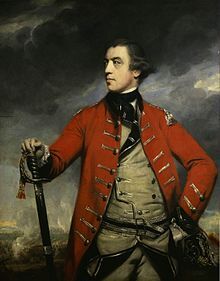 General John BurgoyneAdvance Guard Again
General John BurgoyneAdvance Guard AgainBrigadier General Fraser was put in command of Burgoyne’s advance guard, some 1,200 troops now trained as light infantry. The army launched itself from the mouth of the Richelieu River into Lake Champlain in an armada of Bateaux and canoes. Moving quickly, Fraser’s forces screened the advance on the impregnable Fort Ticonderoga and seized it in a coup de main as the American defenders retreated in the dark of night. Fraser himself led the troops and hoisted up a British flag.
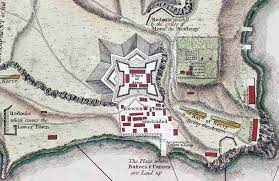 Ticonderoga
TiconderogaA Hot Pursuit
Fraser then launched his advance guard in hot pursuit as the Americans chose to retreat through the dense forests to the south and east rather than take the waterways that led south. The British vanguard stayed on their trail and finally pinned down the American rear guard under Colonel Seth Warner, also an experienced woodland fighter, near Hubbardton. In a back and forth slog the larger American force actually began to have the better of him, but a column of Germans under General von Riedesel helped turn the battle.
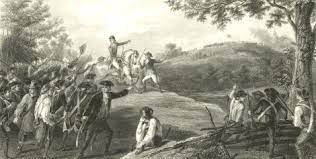 The American militia acquitted itself well against the professionals at HubbardtonSupply Chain Blues
The American militia acquitted itself well against the professionals at HubbardtonSupply Chain BluesThe rest of Burgoyne’s army was now moving south again with Fraser’s brigade at the lead. Albany would fall with just a final drive. But Burgoyne now faced a supply chain problem as he was far removed from his base and shortages began to crop up. In addition, Fraser’s scouts (including some Canadians and Iroquois) were reporting on a large concentration of Americans just north of Albany under the command of a former British officer, General Horatio Gates.
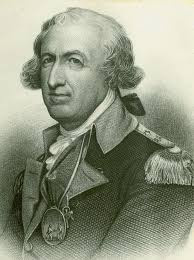 Horatio Gates
Horatio Gates
Burgoyne began to lose his nerve. The other two thrusts had failed and he was on his own. Rather than risk an all-out attack, he launched a reconnaissance in force with Fraser’s commanding the right-wing – through heavily wooded and rugged terrain.
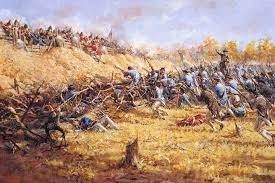 Freeman's Farm
Freeman's FarmClash of Titans
There, Fraser’s elite force ran head-on against their American counterpart, the corps of Virginia and Pennsylvania riflemen under Colonel Daniel Morgan. Morgan’s riflemen sported long rifles with grooved barrels enabling accurate fire well over one hundred yards. Fraser's brigade included the tip marksmen in the British Army. The lead flew as the best of both armies peppered each other and finally, Morgan’s force was driven back, leaving an opportunity to exploit the situation and fight their way around the American flank.
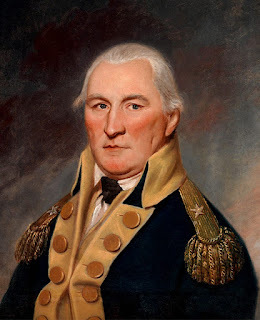 Dan Morgan
Dan Morgan
But Burgoyne did not approve and instead withdrew his army back to its camp to figure out the supply situation. That situation only deteriorated and with autumn getting longer in the tooth, Burgoyne was forced into a desperate situation. This time, it was a probing attack. The idea was to feel out the enemy and exploit any weaknesses. He launched his probe on 7 October in what would become the Battle of Bemis Heights.
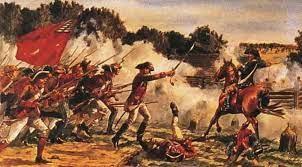 Bemis HeightsFrenzied Fighting
Bemis HeightsFrenzied FightingFraser was once again in the thick of things with his brigade. But the Americans did not seem to bend and in fact, began to launch savage counterattacks all along the front, led by General Benedict Arnold. British forces stood and then withdrew under the pressure of American volleys and bayonet charges. Fraser time and again rallied units and formed the line. Mounted, despite the sheets of lead humming everywhere, he waved his saber.
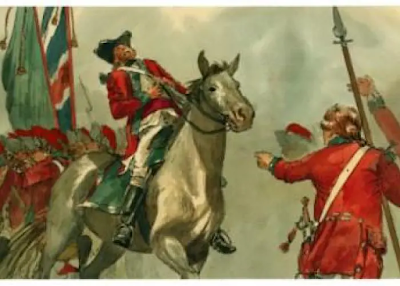 Fraser struck on the third shot
Fraser struck on the third shotIn the Crosshairs
From somewhere far off, an American rifleman cocked his hammer and gazed down the long barrel of his rifle, leveling it on a red-coated figure on a horse. Legend has it the sniper was Private Tim Murphy who allegedly said, “That is a gallant officer, but he must die.” He squeezed the trigger, the hammer cracked down, ignited the firing pan, and launched a ball that just missed Fraser. A second shot struck his saddle but Fraser ignored the fire. Ignoring pleas from his aides, he continued until a third shot struck home with a ball into his belly – a mortal wound.
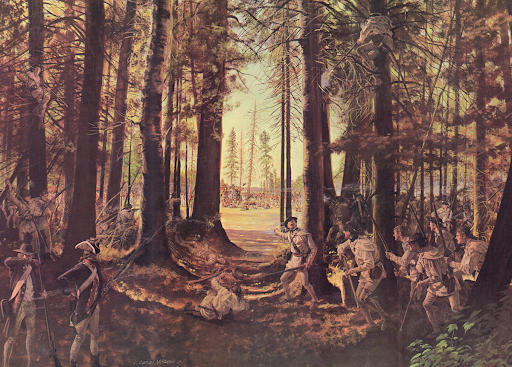 American Riflemen moving into firing positions
American Riflemen moving into firing positionsA Blow to an Army
The fall of Fraser sent a wave of shock through the whole British Army – especially Burgoyne, who soon ordered his battered forces back to their encampment to the north near a place called Saratoga.
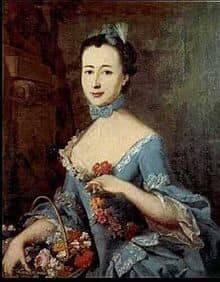 Baroness Fredericka von Riedesel
Baroness Fredericka von Riedesel
Desperate hands wrangled the dying general to the rear where he was nursed by the wife of von Riedesel, Baroness Fredericka, who had accompanied her husband on the wilderness campaign.
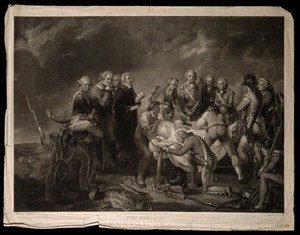 Fraser mourned on the battlefield
Fraser mourned on the battlefieldThe brave highlander died the following day and was buried at the Great Redoubt in a somber ceremony held under the guns and muskets of the encircling rebel army. A stray round from the American artillery nearly disrupted the event. On learning of it, Horatio Gates ordered a gun salute instead. Burgoyne would soon surrender his army, ending the campaign and helping push the indecisive King of France into the arms of the Americans.
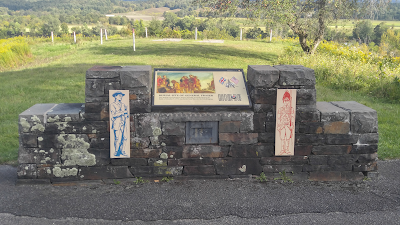 The fighting Scot's exact resting place at the Great Redoubt is unknown
The fighting Scot's exact resting place at the Great Redoubt is unknownDeath's Legacy
Fraser’s life of action and service ended in a way any warrior would have chosen. But Britain lost more than a warrior. It lost one of its best generals and one who thoroughly understood the type of fighting, and the type of fighting man, it would take to win the war. Had he not fallen on that October day, he might have emerged as the leader who could have subdued the colonies for the Crown that subdued his own highland clans. Yet, ironically, the gallant Scot who fought for England, Holland, and German Allies never fought for Scotland - and is most remembered in America.
October 30, 2021
Frustrated Founder
Many leaders in the Continental Army had experience in the British Army and some of them proved quite controversial. Foremost of these was Charles Lee (General Washington’s 2nd in command who allowed himself to be captured by the British and was relieved at the Battle of Monmouth. (see blog post A General Disaster). Another was General Horatio Gates, who was victorious at Saratoga but went down in ignominy at the Battle of Camden. And our profiles of Richard Montgomery (see blog post, First to Fall) and Hugh Mercer (see blog post, Surgeon General from Scotland) demonstrate these men had no lack of courage under fire – giving the last full measure.
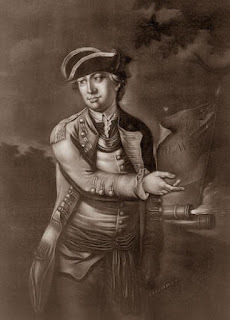 General Charles Lee - one of many former British officers to serve in the Continental Army
General Charles Lee - one of many former British officers to serve in the Continental Army
But this edition highlights a man whose legacy of service to his new nation is complex and, in some ways, tragic. Arthur St. Clair was a man of intelligence and industry whose uneven military talents cloak a career of dedication, patriotism, and no small amount of frustration.
Born in Truro, Scotland in 1736 to a family of some means, St. Clair attended the University of Edinburgh where he studied medicine. In 1757, St. Clair changed his career path by purchasing a commission as ensign in the 60th Foot (Royal American Regiment) and came to America in 1757 to fight in the French and Indian War.
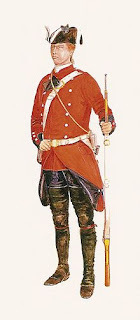 Private - 60th Regiment of Foot
Private - 60th Regiment of Foot
Ensign St. Clair served under famed General Jeffrey Amherst where he helped in the capture of the massive French fortress at Louisburg in July 1758. The following spring, he was promoted to lieutenant and served under General James Wolfe at Quebec and the fighting on the Plains of Abraham, the decisive battle of the war. Lieutenant St. Clair was mentioned in the dispatches for his heroism there when he seized the regimental colors from a fallen soldier and carried them to victory. No piker in the courage department.
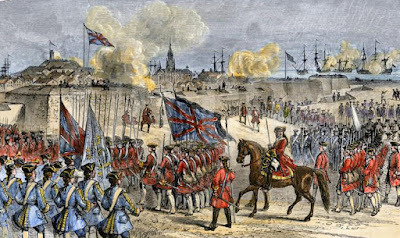 Fall of Louisburg
Fall of Louisburg
His regiment was later stationed in Boston, where Cupid’s arrow struck deeply. Our lovesick war hero married Phoebe Bayard (of the prominent Bowdoin family) in May 1760. Now ensconced in marriage into a prominent clan, the life of a British officer held less promise. So he resigned his commission in 1762 and moved to Pennsylvania to make his fortune as a surveyor. Two years later he settled permanently in Ligonier Valley in the colony’s western frontier, where land was cheap and easy to acquire. He eventually became the largest landholder and one of the most prominent men in the western part of the colony.
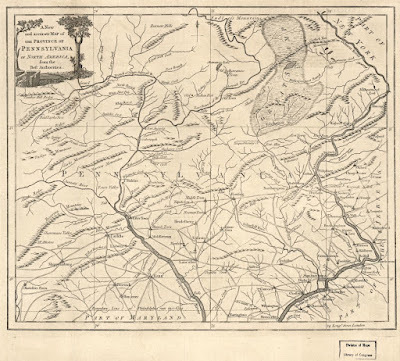
18th Century Pennsylvania
As was typical of prominent men of the time, he began to amass quite a resume of public service to include: surveyor of the district of Cumberland, justice of the court of quarter sessions and of common pleas, member of the proprietary council, recorder, clerk of the orphans’ court, and chief clerk of the courts of Bedford County, which then included the later-day counties of Fayette, Westmoreland, Washington, Greene and parts of Beaver, Allegheny, Indiana, and Armstrong counties. For quite a while, he was the law in a land that was essentially the wild west, overrun with hunters, Indian traders, backcountry settlers, transients, and unsavory characters of all types. He was particularly noteworthy for his fair dealings with the local Indians.
St. Clair was caught up in the territorial disputes between Pennsylvania and Virginia, which claimed a large piece of the western regions of the colony. When Virginian John Connolly seized the area near today’s Pittsburg for Virginia and tried to subvert Pennsylvania’s settlers, St. Clair had him arrested. Virginia’s governor had Pennsylvanians arrested and complained to Governor Penn about St. Clair. The governor backed his magistrate but the border dispute between the two colonies/states was not settled until Congress intervened years later.
As with so many prominent colonial leaders, Arthur St. Clair took a key role in the local militia. In January 1776, he was commissioned a colonel of a regiment, which he raised during the winter and force-marched north to join the invasion of Canada arriving in Quebec on 11 April. But the campaign was already lost with the defeat and death of Montgomery storming Quebec and the American defeat at Chambly. All he could do was help General John Sullivan’s retreat.
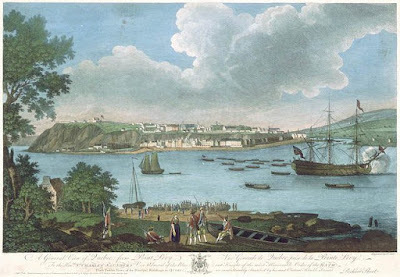 The campaign in Canada was lost by the timeSt. Clair arrived at Quebec
The campaign in Canada was lost by the timeSt. Clair arrived at Quebec
But his knowledge of the area from the last war, and his military experience helped save a large portion of the routed army. St. Clair himself was injured and barely made it back after being cut off by advancing British forces.
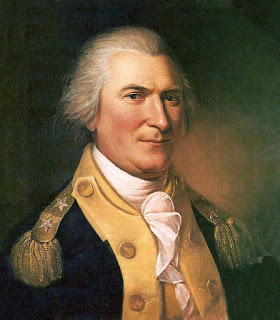 Major General Arthur St. Clair
Major General Arthur St. Clair
He was recognized for his service and talents by a promotion to Brigadier General in August and was ordered to join General George Washington’s army in New Jersey where he took command of a couple of New Jersey militia regiments. The campaign also turned into a rout and Washington’s forces melted away as they retreated from Brunswick to make a narrow escape across the Delaware River.
St. Clair went to work recruiting men for the beleaguered Continental Army and was rewarded with a brigade command, which he led ably at the key American victories at Trenton, Assenpink Creek, and Princeton in the whirlwind counterstrike of December 1776 – January 1777. Some accounts report that St. Clair conceived the brilliant night move from the Assenpink to cut off the British and threaten Princeton. Most of the other commanders recommended a retreat. But Washington took St. Clair’s advice, which led to the victory over the British at Princeton and possibly saved the rebellion from collapse. This explains Washington’s support of St. Clair during later times of controversy.
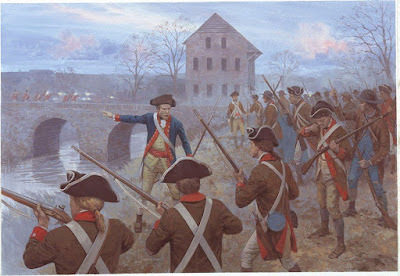 Assenpink Creek
Assenpink Creek
By the spring of 1777, things were heating up once more in the great north. A major army under General John Burgoyne (see blog post, Gentleman Johnny) was marshaling north of Lake Champlain. Continental Congress President John Hancock ordered the newly minted Major General Arthur St, Clair to take command of the strategically placed but undermanned fortress – Fort Ticonderoga. But when St. Clair arrived in early June he found a fort in crisis. Stradling the southern bank of Lake Champlain, the fort was the first objective in a British invasion aimed at taking Albany and dividing the colonies. All had high hopes the fort would be the breakwater to stymie Burgoyne’s red wave.
 General John Burgoyne
General John Burgoyne
But as the Americans should have learned from the debacle at Fort Washington the previous year, a powerful fort that is undermanned is a liability, not an asset. And Ticonderoga was undermanned with men who were ill-fed and ill-equipped. Powder and provisions of all kinds were lacking. Scarcely 2,500 men in a fort requiring 10,000 for a proper garrison. Burgoyne had over 8,000 British and German troops and plenty of artillery and supplies.
 Fort Ticonderoga
Fort TiconderogaOutflanked and Outgunned
The British soon descended on the area and quickly took control of Mount Defiance, where they hauled up a battery that commanded Ticonderoga. Plunging fire would soon shatter the defenses and blast the defenders with impunity. At a council of war, St. Clair decided to evacuate the post and save the army for another day. A wise but controversial decision.
 British guns on Mount Defiance would dominate the areaaround Ticonderoga
British guns on Mount Defiance would dominate the areaaround TiconderogaFlight by Night
The night withdrawal in the face of an overwhelming enemy was a huge risk. St. Clair pulled it off, but not without a major snafu when French-born General Fermoy’s unexplained fire at his quarters alerted the British. With redcoats and Germans hot on their heels, the beleaguered Americans fled through the woods; a water route was eschewed except for the wounded. St. Clair hoped not only to save his army but to lure the British away from their axis of advance, delay their advance, and stretch their supply lines.
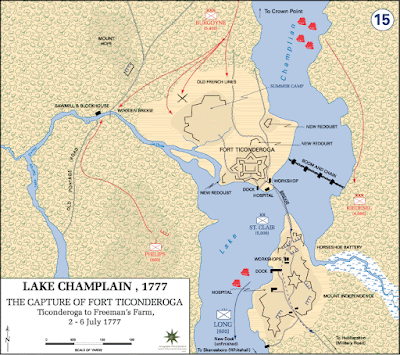
Retreat, Divide and Conquer?
He split his forces and the rear guard delayed the British pursuers, who were after them like hounds on a rabbit. St. Clair hoped to divide the British and siphon them into the deep northern woods rather than sail effortlessly down Lake George. They were barely ahead of the enemy. General Simon Fraser’s advance guard – the elite of the British army, collided with some of St. Clair’s forces at Hubbardton. It was a hard-won victory for Fraser. Another British force – Germans actually – went down to defeat when they tried to alleviate a worsening supply situation by taking livestock at Bennington in today's Vermont.
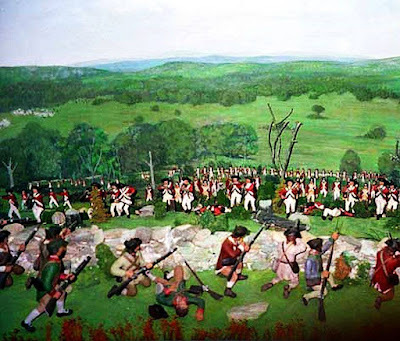 Hubbardton - a defeat, but also a diversion
Hubbardton - a defeat, but also a diversion
Regardless of the wisdom of St. Clair’s successful retrograde: he diverted and slowed the British,
divided their army, extended their supply lines, and kept a valuable field force from marching into captivity, St. Clair was decried from all quarters, but most especially by those who wanted General Horatio Gates to replace Washington as commander in chief. Although the precious 2,500 men he saved provided the core of the forces that General Horatio Gates had on hand to defeat the British as Saratoga, St. Clair was relieved of all command.
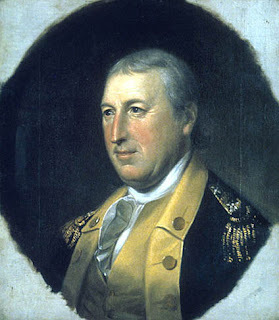 General Horatio Gates
General Horatio Gates
Yet General Washington continued to support him and recalled him to the main army, where he stayed at the commander in chief’s side and served as an aide at the Battle of Brandywine in September 1777. At St. Clair's request, a court-martial was held in 1778. St. Clair was acquitted, “with the highest honor, of the charges against him.” But any hope of battlefield command was over.
He continued serving, however, and was at Washington’s side when General Cornwallis’s army grounded muskets at Yorktown in October 1781. The war in the south was still a thing, and St. Clair was given the mission of marching a column of troops into the Carolinas to reinforce General Nathanael Greene, who was trying to mop up British garrisons from Ninety-Six to Charleston and Savannah. St. Clair's Pennsylvania street cred came in handy when a serious mutiny took place among the Pennsylvania Line regiments in 1783. St. Clair was called upon to appeal to his fellow Pennsylvanians, and he helped to calm the mutineers who gave up on plans for an armed march on Congress.
 Yorktown surrender
Yorktown surrender
St. Clair returned to Pennsylvania and began a career of distinguished political service to the new nation. He joined the Pennsylvania Council of Censors in 1783. Later, St. Clair was elected a delegate to the Confederation Congress. During his term of office from November 1785 through November 1787, he helped instantiate the new national government. It was a time of firsts and a time of troubles. In February 1787 the members met and elected St. Clair President of the Confederation Congress (essentially leader of the national the Federal level). A lot crossed his plate during his one-year term.
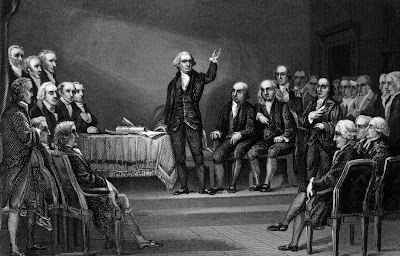 Confederaton Congress
Confederaton Congress
Shays's Rebellion broke out in 1787 over tax disputes. Disgruntled farmers, mostly war veterans marched against their state government. Despite the disruptions caused by the political crisis over Shays's rebellion, Congress managed to pass a seminal piece of legislation during his presidency – the Northwest Ordinance. This would set the template for western expansion and governance and admission of new lands into the United States. And most importantly during St. Clair's presidency, the Philadelphia Convention was drafting a new United States Constitution, which would abolish the old Confederation Congress for a more powerful federal system made up of three branches.
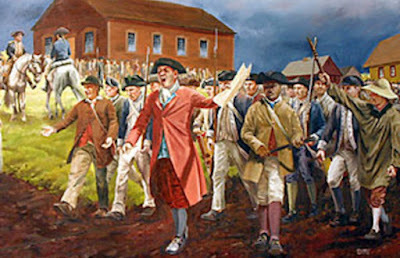 Shays's Rebellion
Shays's Rebellion
With the formation of the new Northwest Territory, congress named Arthur St. Clair the first governor. The Northwest Territory comprised what is now Ohio, Indiana, Illinois, Michigan, and parts of Wisconsin and Minnesota. Making his seat of government the settlement he named “Cincinnati,” he set to work. His achievements were noteworthy in helping settle and tame the land, as well as preparing it for eventual integration into the United States. As a former magistrate, he gave the territory its first body of laws, called Maxwell’s Code. He invested funds, often personal, in helping clear land for settlement.
St. Clair’s western accomplishments were not without controversy. He began the construction of forts to protect the settlers and fend off the tribes. He negotiated the treaty of Fort Harmar – pushing the Indians from their tribal land. Rather than settling the Indian claims, the treaty provoked them into outright conflict.
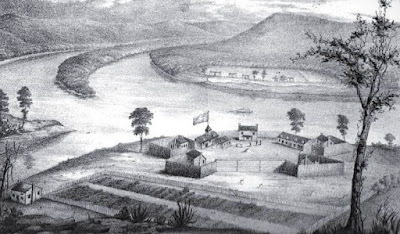 Fort Harmar
Fort Harmar
The tribes took up the tomahawk and went on the warpath - sending panic among the western settlers. Chief Little Turtle and Shawnee Chief Blue Jacket led the coalition aided by former British Loyalists Alexander McKee and Simon Girty. The tribes defeated a 1,500-strong militia force under General Josiah Harmar in October 1790.
 Chief Blue Jacket
Chief Blue Jacket
The following spring, St, Clair was promoted to major general of the army of the United States and led the response himself. Once more in uniform, he took to the field in October 1791 at the head of two Regular Army regiments and militia – a column of 1,400 men who marched deep into the Ohio wilderness to the headwaters of the Wabash River. Meanwhile, thousands of Miami, Delaware, and Shawnee braves were gathered in the dense forests just waiting for a chance to wreak havoc on the hated enemy.
 St. Clair was appointed major general a second time
St. Clair was appointed major general a second timeMassacre
The trap was sprung on 4 November – the warriors unleashing terrific sheets of lead into the Americans, who fell in scores. Down to last than half his force, St. Clair led a desperate bayonet attack to hold off the warriors who were closing in for the final kill. He managed to extricate the survivors but at the cost of over 600 killed and 300 wounded. The Battle of the Wabash stands as the greatest disaster in what would become a long series of conflicts between the oncoming Americans and the Indian tribes.
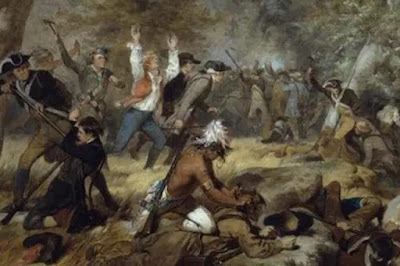 St Clair's defeat at the Wabash
St Clair's defeat at the Wabash
St. Clair was severely condemned by all, including his long-time ally, President Washington who launched an investigation into the causes of the disaster – the first investigation of the executive branch under the new United States Constitution. The inquiry exonerated St. Clair of wrongdoing but he was forced to resign from the army.
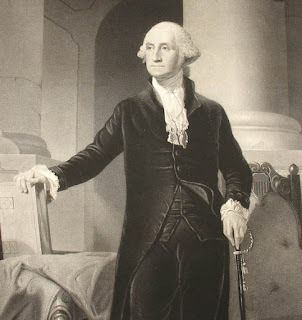 President Washington launched an inquiry
President Washington launched an inquiry
St. Clair was able to stay on as governor of the Ohio Territory – a tribute to a mix of politics (he was a staunch Federalist in a Democratic-Republican west) and his acknowledged administrative capacity. The republic had devolved into rabid partisan politics and the frontier was not excluded. St. Clair wanted to carve two Federalist-leaning states out of the Ohio Territory. He hoped that would bolster Federalist power in Congress. To that end he made vast personal investments in the region but the always cash-strapped federal government failed to reimburse him.
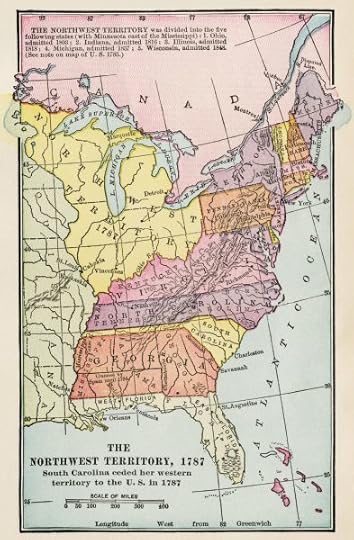 Northwest Territory - St. Clair's Legacy
Northwest Territory - St. Clair's Legacy
The Democratic-Republicans in Ohio opposed him and accused him of partisanship, duplicity, and arrogance. He did not help his case – pushing back on direction from the new capital in Washington and its now Democratic-Republican administration. An 1802 statement eschewing Congress’s control over the territory led to President Thomas Jefferson removing St. Clair from the office he held for well over a decade.
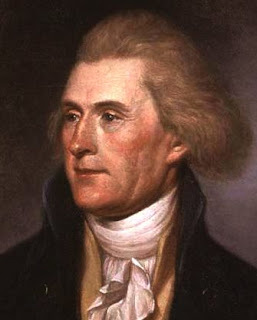 President Thomas Jefferson removed St. Clair
President Thomas Jefferson removed St. Clair
Losing his western investments and bereft of funds, St. Clair retired to western Pennsylvania. He and his wife lived with their daughter, Louisa St. Clair Robb, and her family in a cabin situated between Ligonier and Greensburg. Arthur St. Clair died in poverty in Greensburg, Pennsylvania, on 31 August 1818. He was 81. His wife Phoebe died shortly after and is buried beside him under a Masonic monument in St. Clair Park in downtown Greensburg.
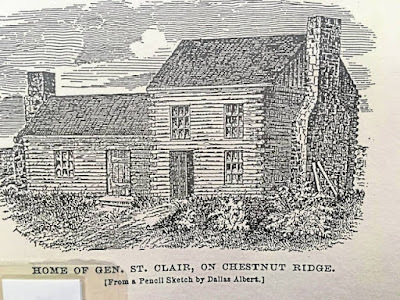 St. Clair's final home
St. Clair's final home
Despite being frustrated by two controversial military defeats, St. Clair was a good officer, a capable general, and most importantly, an adept military thinker. Why else would Washington keep him at his side after Fort Ticonderoga? He was a very good administrator and his efforts helped not just win a nation but build one both at the seat of government and its wild -frontier. This makes the little-known medical student from Scotland among our nation's founders in every sense of the word.
 St. Clair's Grave
St. Clair's Grave
September 30, 2021
Gentleman Johnny
This edition of the Yankee Doodle Spies begins a series of profiles of key historical figures in the next novel in the acclaimed series, The North Spy. In a spoiler alert of sorts, this installment of the adventures of Jeremiah Creed is built around the British invasion of New York from Canada in 1777. No one is more central to that affair than John Burgoyne.
The flamboyant and controversial on his best days, Burgoyne is the archetypal noble cum warrior cum literati-cum celebrity. Archetypal as an extremely unique personality can be… His sobriquet, Gentleman Johnny sums up his soldiers’ view of him – and his view of himself.
Military Brat or Bastard?Burgoyne was born 24 February 1722 in Sutton, to Captain John Burgoyne and his wife Anna Maria, the daughter of a wealthy merchant. Speculation is young John could be a bastard – the illegitimate issue of Lord Bingley. Bingley became John’s “godfather” and put him in his will as his heir if his daughters did not produce male heirs of their own.
There was certainly money to give John a running start in life. So at age 11, Burgoyne began attending the Westminster School in London. There he made some useful friends (always the intent) including Thomas Gage – future General and last Royal Governor of Massachusetts. Another close friend was James Smith-Stanley, aka Lord Strange, son of the wealthy and powerful Lord Derby. At 15, Burgoyne entered the British Army by purchasing a commission in the Horse Guards.
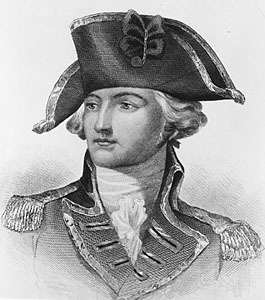 John Burgoyne
John Burgoyne
Since the Guards were stationed in London and his duties were light, he had plenty of time and opportunity to mingle with high society. He soon acquired the nickname, "Gentleman Johnny" for his stylish uniforms and fast living. But he quickly amassed large debts and it is believed he sold his commission in 1741 to settle them.
Return to the ColorsThe War of the Austrian Succession gave the young dilettante a chance to “reinvent” himself, or better yet, resurrect his military career. The British Army was expanding to meet the threat from France and in April 1745, he was commissioned in the newly formed 1st Royal Dragoons. Unlike most “bought” commissions, as a new regiment, Burgoyne received his commission at no charge. Promoted to lieutenant later that year, he served with his regiment at the Battle of Fontenoy where he led troopers in several charges against the French. By 1747, Burgoyne had enough money to purchase a captaincy – a rank that would provide the platform he needed to get noticed but the end of the war in 1748 cut off any prospect of further active service.
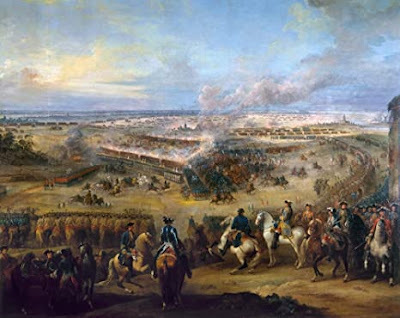 Battle of Fontenoy
Battle of FontenoyCupid’s Arrow
After the war, Burgoyne began to court Charlotte Stanley, sister of his close friend at Westminister School, Lord Strange. When Charlotte's father, Lord Derby, disapproved of the match, John and Charlotte eloped – causing scandal and her father to cut her substantial allowance. Since officers on inactive service received no pay, Burgoyne was forced to sell his commission for 2,500 pounds. The young lovebirds began traveling around Europe, mostly in France and Italy. But it was not all about love. During this period Burgoyne became an avid fan of the arts and literature, and this sojourn would help feed his muse. He also began to study treatises on warfare and tour battle sites and fortresses.
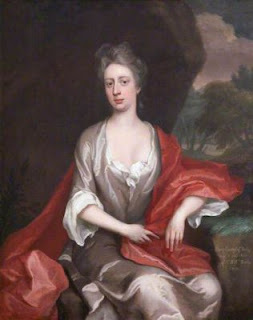 Cupid's Arrow
Cupid's Arrow
When his wife gave birth to what would be their only child, Charlotte Elizabeth, they went home to Britain. Arriving in 1755, his former schoolmate Lord Strange helped the couple reconcile with Lord Derby, who in turn helped Burgoyne purchase a captaincy in the 11th Dragoons. In 1758, Burgoyne moved to the elite Coldstream Guards where the ongoing Seven Years War helped rocket him to the rank of lieutenant colonel. In June 1758, he took part in a raid on St. Malo, France, where British forces burned French shipping. This was followed by another raid on Cherbourg under then Captain Richard Howe, who as Admiral would later command the Royal Navy in North America during the American War.
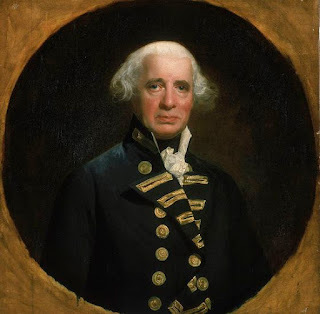 Richard Howe
Richard Howe
But John Burgoyne soon had new ambitions – command of one of the British Army's two new cavalry regiments, the 16th Light Dragoons. The new unit offered John the chance to put some of the ideas he had developed on military science into action. Burgoyne was no dilettante now. Unlike others who did not get directly involved in the administration of their regiments, he directly oversaw the stand-up of his unit and personally recruited officers from the landed gentry in Northamptonshire. He wanted a model unit, organized and equipped around his notions of military service: honorable officers, a firm sense of duty, and well-trained and equipped men who were treated with respect. He did not want his men to be the stereotypical dregs of society. To entice quality recruits, he tried to ensure his men had the finest horses, uniforms, and equipment.
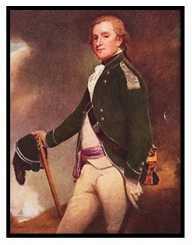 Young Cavalry Commander
Young Cavalry Commander
In contrast to British Army norms and tradition, Burgoyne encouraged his officers to get to know the “other ranks.” His notion of warfare required the men to be free-thinking in combat – not mid-18th century robots a la Frederick the Great. To achieve this, he wrote and published a transformational regimental code of conduct. He expected better-educated officers too – encouraging them to take time each day to read and learn French as some of the best military texts were in French, such as the writings of Marechal Maurice de Saxe.
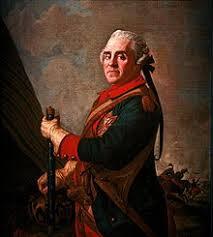 Marechal Maurice de Saxe
Marechal Maurice de Saxe
Somehow, Burgoyne found time (and money) to get elected to Parliament for Midhurst in 1761. But the next year he was off to Portugal a new brigadier general. He gained laurels for taking Valencia de Alcántara and then defeating the Spanish in the Battle of Vila Velha. During the battle, Burgoyne directed Lieutenant Colonel Charles Lee, future Deputy Commander of the Continental Army, to charge a Spanish artillery battery.
 Charles Lee
Charles Lee
Burgoyne returned to Britain at the end of the war. In 1768 was returned to Parliament and got himself appointed governor of Fort William, Scotland. He was outspoken and rather “progressive” in Parliament – speaking for military and colonial reform, particularly in the East India Company. By now he was a major general but a large portion of his time was given over to the arts. He had enough time on his hands to pen plays and poetry. In 1774, his play The Maid of the Oaks was performed at the Drury Lane Theater.
 Drury Lane Theater
Drury Lane TheaterMember of the Dream Team
When the American colonial resistance exploded into a war in April 1775, Lord George Germain, Minister for the Colonies, dispatched three of the most promising officers willing to confront the Americans (several others eschewed service against fellow Britons). So the dream team of John Burgoyne, William Howe, and Henry Clinton, all highly experienced and renowned veterans, sailed to Boston. With General Thomas Gage in command, there was a surplus of brass so Burgoyne exercised no field command. However, the debacle at Bunker Hill and the siege gave him ample opportunity to learn from others’ mistakes.
 General Thomas Gage
General Thomas GageHome and Back and Home
Frustrated, Burgoyne sailed back to England in November 1775. His wife Charlotte died in February 1776, adding to his heartache. Although Burgoyne never remarried, he would begin a long affair with a married actress, Susan Caulfield, by whom he had four children between 1782 and 1788. The four were brought up in Lord Derby's household, and the eldest became Field Marshal Sir John Fox Burgoyne.
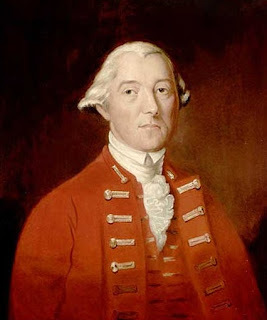 General Sir Guy Carleton
General Sir Guy Carleton
His wife gone and anxious to prove himself, Burgoyne returned to North America in the spring. This time arriving at Quebec, where he served under Governor Sir Guy Carleton, who had just stopped the American invasion. Although Carleton managed to push American forces from Canada – he failed to follow up with a drive on Albany, NY. Burgoyne became critical of Sir Guy’s caution and once more sailed for Britain.
A Brilliant SchemeAmong his other traits, Burgoyne was a smooth talker. Once back in London, he set about pressing the Minister for the Colonies (and point man for defeating the rebellion), Lord Germain, on his plan to win the war in 1777. A three-pronged pincer with a thrust south from Lake Champlain to seize Albany supported by a detachment under Lt. Colonel Barry St. Leger approaching from the west through the Mohawk Valley. A northward advance up the North (Hudson) River from New York led by Sir William Howe would seal the Americans' fate. The objective was to cut off New England from the rest of the American Colonies. Classic divide and conquer. Burgoyne’s scheme would prove brilliant but impractical due to politics and geography.
 Lord George Germain
Lord George Germain
Confusion between Germain and Lord Howe, commander-in-chief in North America, would be its undoing. Howe planned to move south on Philadelphia that year. It is unclear when Germain informed Burgoyne his support from New York City would be minor. Still, Burgoyne landed in Canada and assembled more than7,000 men – British regulars, German auxiliaries, as well as some Canadians and Indians.
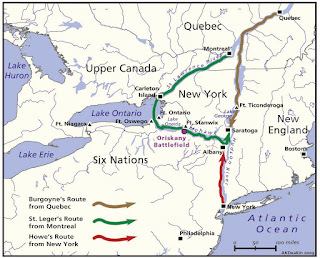 Burgoyne devised a brilliant but complex plan
Burgoyne devised a brilliant but complex planHowe (sic) He Lost
I will not go deeply into this complicated and crucial military event. My future novel, The North Spy, will chronicle most of the major, and some of the minor activities. Burgoyne’s plan was undone by several factors. Time was not on his side as the campaign season in the north was short and he started late and slowly. The terrain was some of the most difficult in Noth America with dense forests and numerous bodies of water and mountains to negotiate. And the Americans rallied most fervently against the incursion, spurred on by atrocities committed by Burgoyne’s Indian allies – both rumored and actual.
Delays & False AssumptionsThe initial delay was gathering enough vessels to exploit the excellent waterways – a virtual superhighway pointing right into the heart of the colonies It was already late June before they arrived on lake Champlain. Burgoyne’s assumption of widespread Loyalist and Indian support gathering around him was immediately dashed. This was a recurring failure in British thinking throughout the war. There was never a large number of Loyal Americans willing to come out and fight – few Native Americans and Loyalists joined his forces. Although Burgoyne took the bastion of the north, Fort Ticonderoga by early July, he made an operational error by pursuing the Americans. He began to stray from his supply line as his men were lured deeper away from the waterways.
 Fort Ticonderoga
Fort Ticonderoga
A minor win at Hubbardton on 7 July only gave him false confidence. And Burgoyne’s advance south towards Forts Anne and Edward was delayed by the retreating Americans who blocked the roads and trails with trees and destroyed any bridges. Around this time he learned Howe was sailing to Philadelphia – the critical thrust from the south would not be. Meanwhile, the supply situation worsened as the army lacked sufficient transport that could traverse the region's primitive roads.
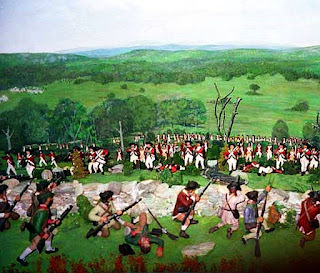 Battle of Hubbardton
Battle of Hubbardton
The need for supplies caused him to send a force of Germans foraging to the east where they stumbled into a hornet’s nest of American militia at Bennington on August 16. The New England militia under John Stark whipped the British, further inspiring men to the cause. Many of Burgoyne’s Indian allies began to sense the changing situation and started to drift off to plunder and go home. To make things worse, Barry St. Leger was turned back at Fort Stanwix. The other leg of the triad was gone. Burgoyne had two choices: consolidate at Fort Ticonderoga and continue the next year – or roll the dice and plunge farther south.
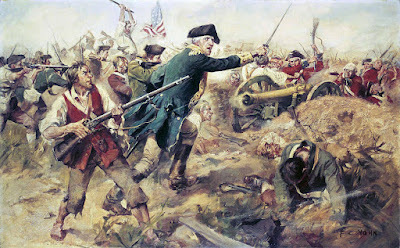 Battle of Bennington The Die is Cast
Battle of Bennington The Die is CastHe took the plunge. Burgoyne decided to abandon his supply lines and try to a “brute squad” push on Albany in time for winter quarters. He crossed to the west bank of the Hudson on 13 September. But just south of Saratoga waited a rapidly growing American army dug defense works designed by famed Polish engineer Thadeuz Kozciusko at a place called Bemis Heights. The weak Major General Horatio Gates commanded the force of mostly New England and New York militia – but he also had some crack continental troops sent north by George Washington. Gates may have been "Granny" (his nickname) but the next line of command had some of the best leaders of the war including, Brigadier General Benedict Arnold, Colonel Dan Morgan, Enoch Poor, Ebenezer Learned, and Benjamin Lincoln.
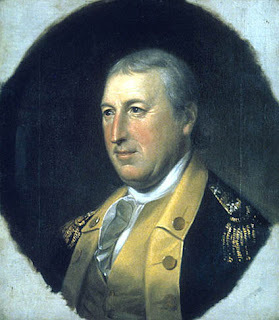 General Horatio Gates
General Horatio GatesFreeman's Farm
Burgoyne vacillated. His army was weakened and morale waning. And although Gates was himself content to sit behind his works and wait things out (not entirely a bad notion), he allowed Arnold to try a stratagem. On 19 September, Arnold and Morgan struck Burgoyne's men at Freeman's Farm. Fierce fighting ensued. Both sides were mauled but the British withdrew to regroup.
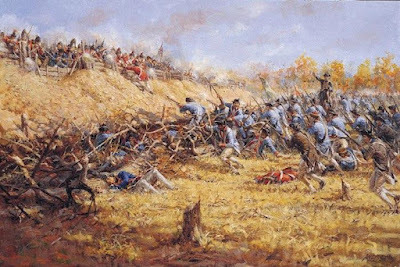 Battle of Freeman's Farm
Battle of Freeman's FarmBemis HeightsWith their supply situation critical, many of the British commanders recommended a retreat. Burgoyne anxiously hoped a small diversion from NYC launched by former dream team member Henry Clinton would draw some of the Americans south of Albany. But Clinton’s move was too little too late. Yet unwilling to fall back to Fort Ticonderoga, Burgoyne tried a last desperate die roll at Bemis Heights on 7 October. A strong column under General Simon Fraser was smashed and Fraser, his best subordinate, was killed by a sniper. So were precious regulars and Germans who would never be replaced. Burgoyne showed personal bravery and was several times nearly shot by American marksmen. When Fraser's column was repulsed, the Americans launched their own attack and punished the British, although they failed to take and hold the British defense works. But Burgoyne had been licked.
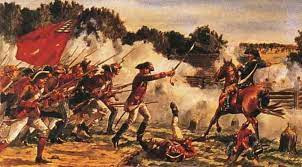 Battle of Bemis HeightsAn “Unconventional” Surrender
Battle of Bemis HeightsAn “Unconventional” SurrenderThe British withdrew to their camp near Saratoga. Meanwhile, the Americans had cut off his retreat north and were harassing his lines daily with sniper fire. Stymied in two pitched battles and with no chance now to fall back on his supply lines or smash his way south, Burgoyne surrendered on October 17 at Saratoga. Yet “Gentleman Johnny” tried to make lemonade from lemons in the way of a technical protocol. He managed to convince Gates (a former British officer) to let him sign a “convention” vice a capitulation via unconditional surrender. Also, he and his men were to be returned forthwith to Britain. Congress later set aside the deal. While the British and German officers returned home on parole, the “other ranks” threw down their arms under the watchful American militia and continentals and some 5,800 marched off to captivity in Boston and ultimately Charlottesville, Virginia.
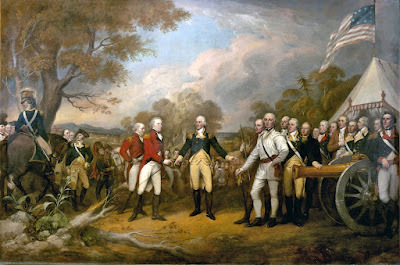 Burgoyne Surrenders at Saratoga
Burgoyne Surrenders at Saratoga
To say Burgoyne returned to Britain in disgrace is an understatement. This was one of the worst defeats in British history – trumping Malplaquet, Fontenoy, or Carillon. The American rabble in arms had destroyed a British army in the field – convincing France to openly ally with the fledgling American nation, later followed by Spain. The impact on world history would be immense.
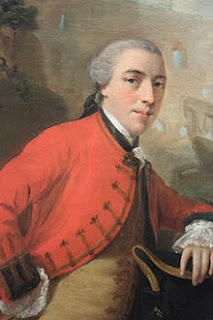 Burgoyne's demand for a court-martialwas denied
Burgoyne's demand for a court-martialwas deniedAttacked by the government for his failures, Burgoyne attempted to reverse the accusations by blaming Germain for failing to order Howe to support his campaign. He demanded but did not receive a court-martial to him of the disgrace. Instead, King George III stripped him of all titles. Once more Burgoyne was out of the army. But not for long.
Political WindsFrustrated by the lack of support from Lord North’s administration, one he had so strongly supported, Burgoyne switched his political allegiance from the Tories to the Whigs. Soon things turned around for Burgoyne.
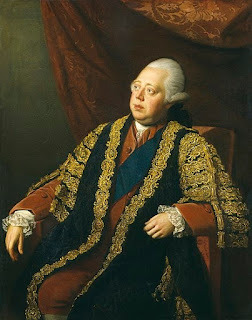 Things went South for Lord North -to Burgoyne's advantage
Things went South for Lord North -to Burgoyne's advantage
When Lord North’s cabinet collapsed in 1782 Burgoyne was in favor with the Whigs and his rank of major general was restored, along with a colonelcy in the King’s Own Royal Regiment. Burgoyne wrangled one of the top appointments in the army – commander in chief in Ireland. He also became a privy councilor. But Burgoyne left government when Lord Rockingham’s government fell a year later. However, this gave him time to concentrate on his literary projects – now his only passion besides his mistress.
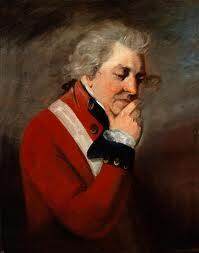 Burgoyne ReinstatedAcclaimed Playwright
Burgoyne ReinstatedAcclaimed PlaywrightBurgoyne wrote two plays, romantic comedies – Maid of the Oaks, written by 1774, and The Heiress, written in 1786, arguably his best work. He also collaborated with Richard Brinsley Sheridan in the production of The Camp in 1778. In 1780, he wrote the libretto of William Jackson’s The Lord of the Manor. Burgoyne wrote the translated version of Michel-Jean Sediane’s Richard Coeur de lion for a semi-opera production at the Drury Lane Theatre in 1788.
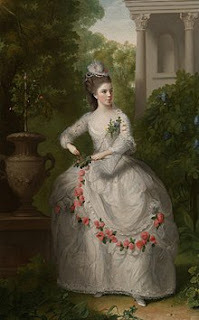 Actress Frances Abington in Maid of the Oaks
Actress Frances Abington in Maid of the Oaks
Despite his failed strategy and campaign at Saratoga, John Burgoyne remained best known for his literary achievements among contemporary and post-Revolutionary War Britons. He was most loved for The Heiress, which proved to be a great success and favorite to many before and after his death. Gentleman John Burgoyne died suddenly at his Mayfair home on June 3, 1792. He was buried at Westminster Abbey.
 Burgoyne's Legacy was his plays
Burgoyne's Legacy was his plays
August 31, 2021
The Tailor Spy
The Irish in the American Revolution have their heroes and villains on both sides of the struggle. Although renowned for decades of resisting and fighting their British oppressors, there was no groundswell of Irish sentiment for the colonials fighting the far-off war. The average Irishman was just trying to survive and many were recruited into the British regiments in Ireland. And in America itself, the Irish immigrants, like the rest of the populace, were split in their sympathies. But one such transplanted son of Erin would play a secret role in helping free his adopted nation – and perhaps take some vengeance on the British.
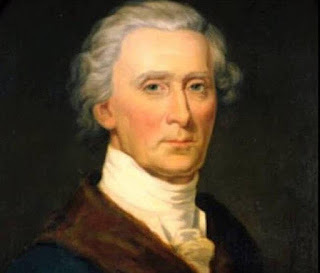 Hercules Mulligan
Hercules MulliganKnown until recently only to historians and a few “buffs” of Revolutionary War skullduggery, the name Hercules Mulligan gained worldwide fame through the hit Broadway musical, “Hamilton.” Indeed, Mulligan’s fate was intertwined with that controversial Revolutionary War officer, political operative, and Founding Father. For Hercules Mulligan and his family, in many ways, gave Alexander Hamilton the boost every new immigrant needs to take things to the next level.
Early DaysHercules Mulligan came to New York City from Coleraine, County Antrim, Ireland, at the age of six, with his parents Hugh and Sarah Mulligan. The year was 1746 – long before the French and Indian War and all the political and economic events that would result in the struggle for America. Hercules's father quickly established himself as a successful New York accountant and the family thrived in the colonies. Along with Hercules came two brothers – of particular interest is his oldest brother Hugh, who became proprietor of an import-export business that took on as a clerk a callow youth from Nevis, one Alexander Hamilton.
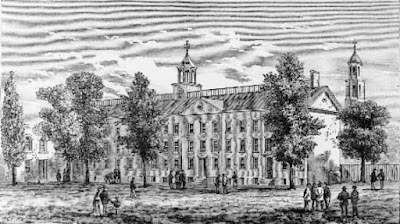 King's College
King's CollegeHercules attended King’s College (now Columbia) and became an accountant until he turned to the haberdashery business. His first shop was along Water Street but he later moved to the more fashionable Queen Street in 1773 so he could attract a more affluent and influential clientele. That same year, his brother Hugh introduced him to the young prodigy, Alexander Hamilton. Hercules took Hamilton under his wing. Hamilton even boarded with Mulligan and his family while he attended King’s College.
Secret PoliticsWhile Hamilton’s politics were shaped at King’s College, it is unclear when and how Mulligan began to sympathize with the rebel cause. Perhaps latent Irish sympathies and anger at the cruel Penal Laws in his native land? Or was it the course of events that followed the French and Indian War – the same events that pulled over one-third of the king’s loyal subjects towards a different political system? But the connection, the bond, was clearly sealed in those early days of simmering revolutionary fervor.
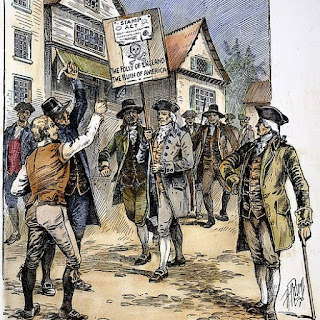 Stamp Act Protest
Stamp Act ProtestAt some point along the way, probably as early as 1765, Hercules helped pen an anti-Stamp Act underground tabloid called The Constitutional Courant. Mulligan later became a founding member of a radical wing of New York’s Sons of Liberty, organized to defend the colonists’ rights and resist British taxation. He was also was a participant, if not a leader, of the Sons of Liberty-inspired mob that, in 1770, attacked British soldiers in what was called the Battle of Golden Hill.
 Battle of Golden HillA Model Citizen
Battle of Golden HillA Model CitizenAlthough he had a secret political life, Hercules outwardly remained a member of the establishment. The young Irishman married well – his wife was Elizabeth Sanders, the niece of a Royal Navy admiral and a well-connected member of New York's elite. The gregarious Irishman utilized his wife's family connections to build his business to cultivate friends and acquaintances among New York’s upper crust – most of whom were staunch Loyalists. Later, when New York was garrisoned by increasing numbers of British regulars, he added a coterie of officers as both clientele and contacts.
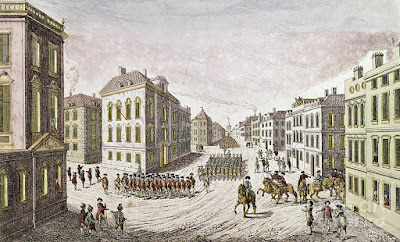 British occupied New York
British occupied New YorkThe gregarious haberdasher placed elaborate ads in Rivington's Gazette and other prominent Tory papers - ads that would draw top-tier customers and officers with their descriptions of “superfine cloths, gold and silver lace, fancy buttons, and epaulets replete with heavy bouillon.” If you build it, they will come. And come they did. Selecting, cloth, accouterments, measuring, and fitting all took time. Time that could result in slips of tongue, nuggets, and the knowing winks of a proud and haughty clientele aimed at impressing the popular haberdasher.
Secret RebelMulligan was at the center of an incident on 24 August 1775, an attempt on the HMS Asia, anchored in New York harbor. Under the cover of darkness, a band of New York militiamen, including Mulligan's company known as the "Corsicans," seized control of the artillery battery at the tip of the Island of New York (Manhattan). Hercules and his young boarder, Alexander Hamilton, were among them. But someone had alerted the crew of the HMS Asia and it unleashed its own guns on the rebels.
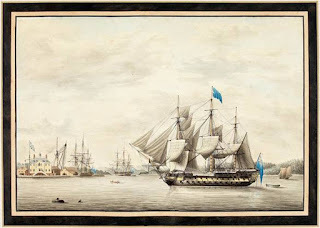
HMS Asia in New York harbor
Mulligan tossed a rope around one of the guns to pull it to safety. As he struggled, Hamilton approached and, small as he was, dragged the gun away. Hamilton then coolly rejoined the front lines to help move more guns – 20 were taken. Interestingly, one of the shots from the HMS Asia struck the roof of Fraunces Tavern – famed for later hosting General Washington’s farewell in 1783. With the support of Hercules, young Hamilton was promoted to captain and commander of an artillery battery in July the next year – just in time for the British onslaught on New York.
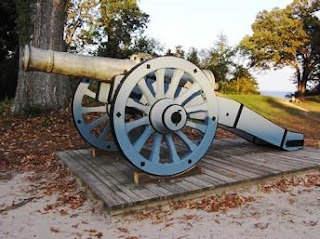 Artillery would team Hercules with Alexander Hamilton
Artillery would team Hercules with Alexander HamiltonIn 1776, Mulligan was one of the Sons of Liberty who tore down a huge statue of King George III in Bowling Green. They later melted down its lead into musket balls for rebel use. He had also joined the New York Committee of Correspondence, a key instrument in rallying support among the populace and keeping the colonies coordinated. An attempt to flee the city failed and Mulligan remained in New York after Washington's army was driven out during the New York campaign of summer 1776. By September of that year, New York was an occupied British city, and the situation called for more than political agitation – it called for espionage. But to do that effectively, Hercules would have to appear a Loyalist. As many flipped their allegiances during this time it did not raise much suspicion.
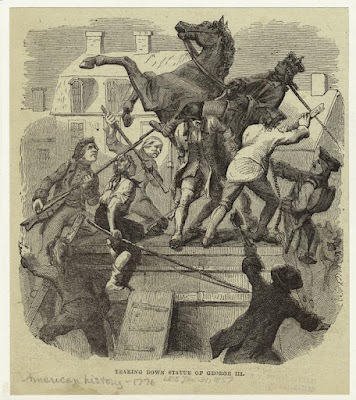 King George III statue tumbling downTailor Spy
King George III statue tumbling downTailor SpyExactly when our “model citizen” became a spy is still unclear. Fittingly, such things were not made a matter of record and secret agents often worked under a cover name, code name, or number. It is believed Alexander Hamilton suggested him to Washington while serving as aide de camp in 1777. But some sources do not have the haberdasher actually reporting to Washington until 1779. In any event, the transition was smooth, if not inevitable.
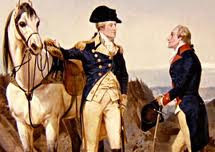 Alexander Hamilton as aide de camp to General Washington
Alexander Hamilton as aide de camp to General WashingtonAt his clothing shop, Mulligan would often measure his clients, chatting them up and picking up nuggets through elicitation. He also was very observant of military and political goings-on in the city. Years waging a secret political war had enabled Mulligan to hone the skills need to be an excellent intelligence operative in the occupied city.
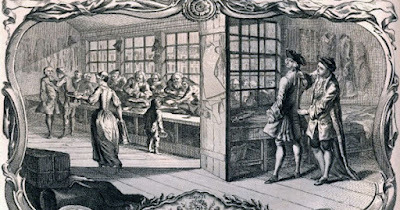 The perfect venue for elicitating nuggets from powerful customers
The perfect venue for elicitating nuggets from powerful customers
As living quarters for men of means became tight in occupied (and fire-ravaged) New York, Hercules opened a few rooms in his home to British officers – an excellent way to avoid suspicion, develop leads, cultivate relationships and elicit intelligence.
There is some belief Mulligan reported through the Culper Ring – the Setauket, Long Island-based spy operation made famous by the fictional TV show, TURN. And he may have done so. The key collector for the ring, Robert Townsend, operated his establishment down the street from Mulligan’s haberdashery. But Hercules used other channels as well. In fact, Washington’s key intelligence officer and spymaster of the Culper Ring, Major Benjamin Tallmadge once queried the commander in chief as to Mulligan’s status and activities. He was concerned Mulligan's activities might pose a threat to his ring. He would not have made the query if Mulligan was one of his assets.
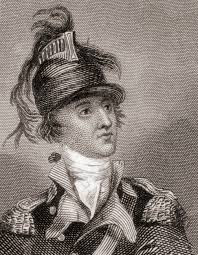 Major Benjamin Tallmadge
Major Benjamin Tallmadge
So how did Mulligan smuggle his intelligence out of the city? One way was through his African American servant, Cato. Cato’s status enabled him to pass through British lines without arousing too much interest as Africans were believed to be pro-British (and most were). It is held by some that Samuel Culper used Mulligan’s servant as an alternate reporting channel on at least one occasion. Cato made many trips across lines but on his last, he aroused enough suspicion to cause his detainers, probably local Loyalist militia, to beat him severely. Despite the brutal treatment, Cato did not give up his mission or his boss. As it was, Mulligan used his high contacts to get Cato released, although his courier days were over.
Fraternal AffairHercules’s older brother Hugh also had a hand in espionage. His import-export firm Kortwright & Company had business dealings with the British military and with many influential Tory merchants in New York. As a shipper, he could visit ships in port, look at facilities and track the movement of supplies – providing valuable information of future British operations.
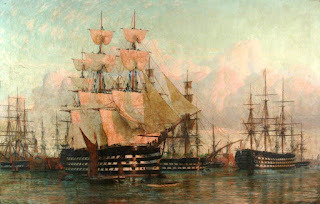 Hugh Mulligan had access to British shipping plans
Hugh Mulligan had access to British shipping plans
There is little known about the specifics of Hercules Mulligan’s reports but he is credited with reporting intelligence that saved General George Washington’s life on at least two occasions. That alone could make him one of the most important people of the war.
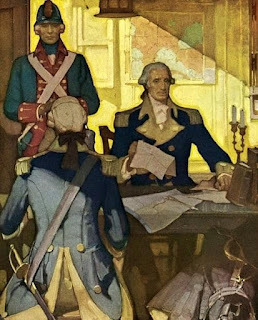 Cato's message from Hercules saved Washington
Cato's message from Hercules saved Washington
On one occasion, a British officer came to Mulligan late in the evening seeking a coat. Hercules began showing him different coats, all the while bantering and questioning his customer, who carelessly spilled the beans – he was setting out to capture George Washington. Mulligan dispatched Cato as soon as the officer left – enabling Washington to move to safety.
The other time, the British learned of Washington’s plan to ride to Rhode Island along the Connecticut shoreline. By pure luck, Hugh Mulligan was contracted to provide supplies for the British vessels. He quickly informed his brother and once more Cato slipped out of the city to warn Washington.
Under SuspicionThe affable and well-connected Mulligan did come under a cloud of suspicion at (at least) one point during the war. Ironically, it came from the notorious traitor himself, Benedict Arnold. Arnold was now in New York with the rank of Brigadier General in the British Army. One of Arnold’s tasks as commander of the West Point garrison had been to help orchestrate collection against the British in and around New York City. In that capacity, he had some inkling the tailor might be one of General Washington's sources.
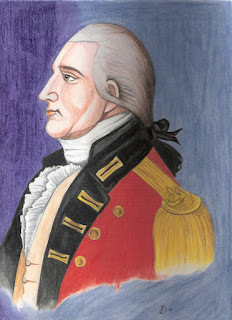 Benedict Arnold - British Brigadier General
Benedict Arnold - British Brigadier GeneralWashington was very good at “compartmentalizing” operations. Very few of even his closest confidants knew who his spies were and those who did had only the knowledge absolutely necessary.
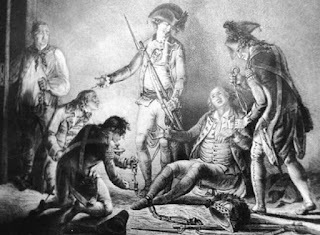 Hercules under questioning
Hercules under questioning
Arnold had Hercules arrested. Having been interrogated twice previously by the British, Mulligan was able to deflect questioning and maintain his aplomb. These skills – combined with his reputation as a loyal subject and friend of the British, carried him through. And because Arnold had no actual evidence to back up his accusations our tailor-spy was soon released.
Under Suspicion (Again)Hercules was a victim of his own success. Playing the loyal haberdasher to the British and Tories for almost eight years solidified his reputation as a collaborator among his fellow New Yorkers – a cynical lot by nature. Patriots and Whigs fingered him for an active Loyalist and traitor to the cause. After the British departed at the end of 1783, his thriving business and position in New York society were at great risk. Many Tories were run out of town and their properties confiscated. There was no reason this would not be the Irishman’s fate.
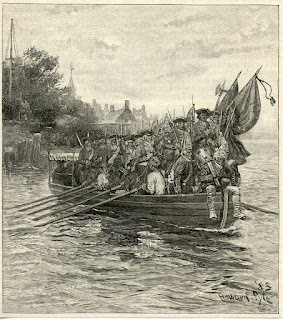 British evacuation of NYC
British evacuation of NYCBut the hand of His Excellency, General George Washington intervened. After the war, Washington is known to have quietly reached out to many hitherto unknowns and made it clear they fell under his special approbation. Many of these are believed to have been clandestine intelligence operatives: secret agents, spies, and couriers.
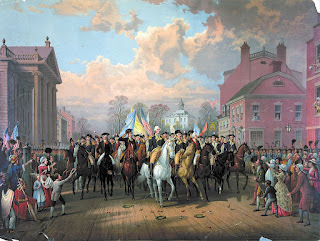 True Friend of Liberty
True Friend of LibertySo while in New York City, a grateful George Washington visited Mulligan’s haberdashery, had breakfast with the man to whom his life was owed, and was fitted for a set of new clothes, dubbing the secret patriot “a true friend of liberty.” This act protected Mulligan from being labeled a British sympathizer and collaborator. Beaming with pride, Mulligan commissioned a sign, which he forever proudly displayed outside his 23 Queen Street (today 218 Pearl Street) store: “Clothier to Genl. Washington.”
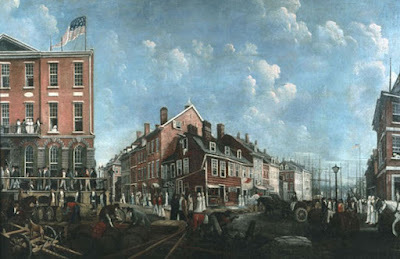 Queen Street post-war
Queen Street post-war
Although Cato’s fate is unknown, Mulligan struggled for democratic ideals in post-war America and co-founded the New York Manumission Society along with his long-term friend, Alexander Hamilton. Our tailor-spy died in 1825 at age 80 and is buried next to Alexander Hamilton in Trinity Church.
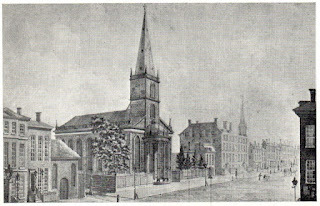 Trinity Church 1776 pre-NYC fire
Trinity Church 1776 pre-NYC fire
July 31, 2021
The Surgeon Spy
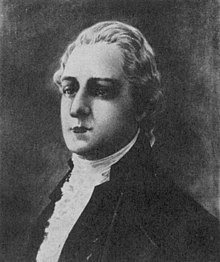 Doctor Benjamin Church
Doctor Benjamin Church
Church was a blue-blooded scion of Yankee forbearers who would be the envy of the Colonial Dames. Born 24 August 1734 in Newport, Rhode Island, the son of Benjamin Church, a Boston merchant and deacon of the Hollis Street Church, Church hailed from a family of New England military, civil and religious leaders that stretch back to the Mayflower through his great-great-grandmother Elizabeth Warren Church – daughter of Richard Warren, who arrived on the Mayflower.
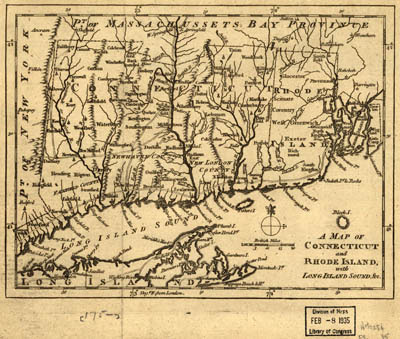 Benjamin Church was born in Rhode Island
Benjamin Church was born in Rhode Island
Young Benjamin studied at the Boston Latin School – the typical springboard to Harvard College, from which he graduated in 1754. He then studied medicine under one Dr. Joseph Pynchon. Following this, like so many American surgeons, he finished his studies in London. There he married Hannah Hill. When he returned home it did not take long for him to build a reputation as one of the city’s best young physicians and surgeons, even treating the lawyer and future founder John Adams’s eye problems.
 Future president John Adams was Church's patient
Future president John Adams was Church's patient
In the decade-long run-up to the break with Britain, Massachusetts, particularly Boston, was at the center of growing discontent and turmoil. Benjamin Church seemed to be right in the middle of things. Following the Boston Massacre on 5 March 1770, it was he who examined Crispus Attucks’s body. He also treated some of the wounded. This seemed to place him an ardent Whig and in 1773, he was called upon to give the annual “Massacre Day” oration, an annual commemoration used to stir up anti-British sentiment. He proved a gifted orator.
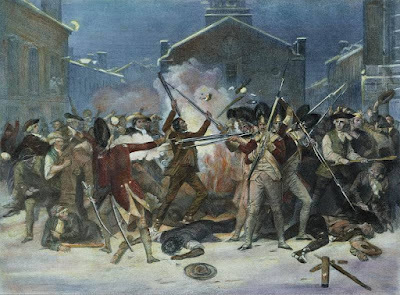 The Boston Massacre
The Boston Massacre
Dr. Church became one of the leaders of Boston’s Sons of Liberty, working among the likes of Joseph Warren, Sam Adams, John Adams, and Paul Revere. By 1774, the prominent surgeon was a delegate to the Massachusetts Provincial Congress – later joining its Committee of Safety, the colonial entity responsible for preparing for armed defense.
Our Surgeon Goes to WarApril 1775 marked the formal outbreak of hostilities between the American colonists, particularly the New England colonists and the Royal authorities. Although impendence was not yet the stated goal, the fight for the rights of the Americans had all the trappings of war. And our favorite surgeon was caught up in the middle of it. In May 1775, Church traveled to Philadelphia where he consulted with Congress about the military situation in Massachusetts. As head of the Committee of Safety, he signed the order mandating the building of defense works at Breed's Hill and Prospect Hill.
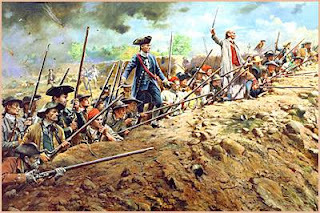 Breed's Hill defenses
Breed's Hill defensesIn July 1775, he was named Director General and Chief Physician of the newly established Medical Department of the Army making him head of both the hospital department of the first army hospital and of the first headquarters of regimental surgeons. This was a prestigious appointment, essentially putting him at the pinnacle of his profession.
Doctor Gloom?Interestingly, Church proved an indifferent medical administrator and had a barrage of complaints lodged against his medical system management by the army’s regimental surgeons. He pushed back – citing jealousy as the real motivation of his accusers and soon requested to be relieved of his duties. Why would a renowned and highly trained surgeon (18th-century term for a physician) have a hint of failure at what should be a core competency? Perhaps our doctor had other things on his mind.
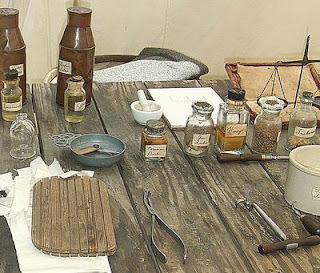 As chief army surgeon, Church was responsible for medical suppliesOther Things
As chief army surgeon, Church was responsible for medical suppliesOther ThingsAnd other clouds were swirling about the upstanding Whig leader. In the espionage world, these were called anomalies and indicators. And although they were there – it would take an overt event to begin to bring things together. There were suspicions of his allegiance to the cause, especially the cause of independence. At this time there still may prominent Whigs who were ambivalent to a complete break with Britain. But was he one of them?
Yes, Church had an English wife and his brother-in-law a prominent Tory printer, John Fleming. But so many had ties to Britain and the Tories that he could not be considered completely abnormal. In the run-up to rebellion, Church developed a reputation as a prominent patriot writer and poet. But as it turns out, he sometimes responded to his own patriotic open letters in the press with “op-ed” pieces taking the Tory side!
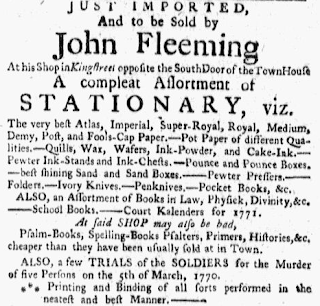 Advertisement for John Flemings Printshop
Advertisement for John Flemings Printshop
As it would later turn out, he also had at least one meeting with General Thomas Gage, which was reported, probably by the Mechanics, a spy network run by Paul Revere (see the Yankee Doodle Spies post on them). Church explained it away – as many suspected spies all too easily do. What was then unknown, was Church was in debt, some of which was caused by his keeping a mistress. And she was not his first, as it turned out.
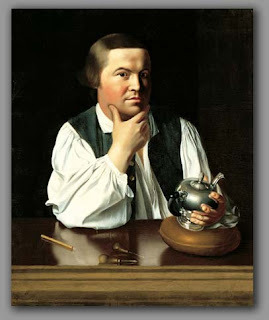 Did Paul Revere's Mechanics have the doctor in their sights?
Did Paul Revere's Mechanics have the doctor in their sights?A House of Cards
In July 1775, Doctor Benjamin Church’s house of cards collapsed when a secret letter was intercepted and decoded. A cipher letter was sent to a British officer in Boston, named Major Cane, through a former mistress. But Eros intervenes in strange ways – the letter was intercepted by another of the woman's ex-lovers, and be sent to the new Continental Army commander-in-chief, General Washington in September. It took some effort to decode it but they were rewarded for their efforts as it contained information about the American forces gathered around Boston. Although little of the information was critical, the missive showed clearly Church’s allegiance to the King and sought instructions for further secret correspondence. A bombshell striking Washington’s headquarters could not have been more explosive than this news!
 King George IIIA General Court Martial
King George IIIA General Court MartialAt the court-martial in Cambridge, which immediately followed, Church admitted penning the letter (typical ploy) but declared he intended to impress the British with the Continental Army’s strength to prevent an attack while it was still short of ammunition. And he thought it might help bring about an end to hostilities. Although impressing the British probably helped Washington’s situation, the latter was an indicator of Church’s ambivalence. Because there was no “espionage statute” and America was not yet an independent nation and thus could not be “betrayed,” the court, with Washington presiding, determined Church engaged in a “criminal correspondence with the British.”
 General Washington penned a report following Church's court-martialReport to Congress
General Washington penned a report following Church's court-martialReport to CongressOn Oct. 5, 1775, General George Washington wrote the President of the Continental Congress, John Jay, to inform him that a letter from Dr. Benjamin Church, surgeon general of the Continental Army, to Lt. Gen. Thomas Gage, the British commander in chief for North America, had been intercepted. His case was then referred to the Continental Congress for punishment with this report from Washington to the President of Congress:
I have now a painful though necessary duty to perform, respecting Doctor Church, the Director of the Hospital. About a week ago, Mr. Secretary Ward, of Providence, sent up one Wainwood, an inhabitant of Newport, to me with a letter directed to Major Cane in Boston, in occult letters, which he said had been left with Wainwood some time ago by a woman who was kept by Doctor Church. She had before pressed Wainwood to take her to Captain Wallace, Mr. Dudley, the Collector, or George Rowe, which he declined. She gave him the letter with strict injunctions to deliver it to either of these gentlemen. He, suspecting some improper correspondence, kept the letter and after some time opened it, but not being able to read it, laid it up, where it remained until he received an obscure letter from the woman, expressing an anxiety as to the original letter. He then communicated the whole matter to Mr. Ward, who sent him up with the papers to me. I immediately secured the woman, but for a long time she was proof against every threat and persuasion to discover the author. However she was at length brought to a confession and named Doctor Church. I then immediately secured him and all his papers. Upon the first examination he readily acknowledged the letter and said that it was designed for his brother, etc. The army and country are exceedingly irritated.
Crime and PunishmentBecause of the lack of actual laws – and the lack of a death sentence, Church was sentenced to prison an indeterminate prison term. and held in solitary confinement at Norwich, Connecticut. When he got sick in January 1776, he was released from jail and was allowed to move around under guard. In May of that year, he was sent back to Massachusetts under bond and remained imprisoned until 1778, when the Massachusetts Banishment Act of that year ordered him exiled to Martinique in the West Indies. Shortly thereafter he sailed from but the schooner carrying him was never heard from again. It was assumed it went down in a storm on the high seas.
 Church would spend most of his life in prisons before exile
Church would spend most of his life in prisons before exile
Doctor Benjamin Church’s case was one of those enigmas of the American Revolution. Many believed he was misjudged. He certainly thought so. After all, his credentials, services and pedigree were impeccable. And although he admitted to certain acts – he adamantly insisted he was simply keeping channels open and trying to feed the British useless information. Torn between two allegiances, he may have actually believed his own story.
Yet he was in debt, had mistresses, and clearly had the ego to take bold action. Was his visit to British held Boston to meet the Royal Governor and commander in chief General Gage an act of perfidy or misguided statesmanship?
 Did a mistress or mistresses do him in?
Did a mistress or mistresses do him in?
Years later – the truth did come out. When scholars were able to open General Gage's files. In the early 20th century, the papers of General Gage were made available to historians. These contained letters with chock full of information on the rebel army – correspondence carried by Church. that could only have come from Church. The good doctor was indeed providing the British army with intelligence from at least early 1775, possibly earlier.
 General Thomas Gage's files finally outed the spyA Spy’s Motive
General Thomas Gage's files finally outed the spyA Spy’s MotiveWhy did the esteemed doctor Benjamin Church play the espionage game? Was overburdening debt? Disputes and scores against rivals in the American leadership? Ambivalence towards actually breaking with Britain. Family connections? Loyalty to the crown? Or perhaps it was for the most frustrating reason of all – simply because he could.
June 29, 2021
The Sculptress Spy?
Viewers of the hit TV series TURN, aka Washington’s Spies, are familiar with a sexy femme fatale artist who was a spy for the American cause in London and met her demise in a bloody execution. But the real Patience Wright was more of an enigma, although perhaps more controversial than her TV persona.
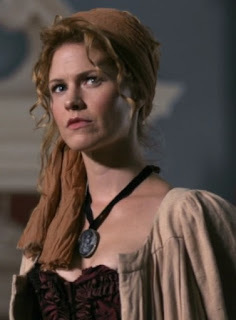 Kate MacCluggage as Patience Wright in TURN
Kate MacCluggage as Patience Wright in TURN
Who would have supposed a vegetarian and Quaker girl from the seaside hamlet of Oyster Bay, New York, would move in circles that included Ben Franklin and the king of England? In 1729, when Patience Lovell was four, her family moved from Long Island (coincidently not far from the locale of the Culper spy ring) to New Jersey. Patience Lovell grew up in Bordentown, not far from Philadelphia, the largest city in the colonies and home to the largest Quaker community.
At sixteen, the rambunctious Patience left her family and the quiet farming town of Bordentown for the busy streets of Philadelphia where, in 1748, she married a barrel maker named Joseph Wright. They would have four children together, by the time he died in 1769.
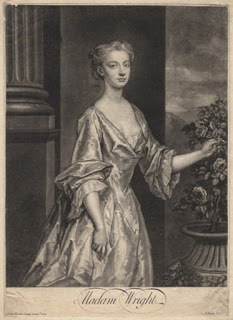
Faced with poverty, the new widow Patience turned her hobby of molding wax figures into a small business venture with her sister, Rachel Wells, also a widow. Their waxworks became very popular – the figures said to be very life-like, a la Madame Tussaud of later years. Her work was very popular and she eventually had a shop in New York. It is unclear when and where Patience developed her talent for making wax figures, but she was known to have molded them into various shapes and figures to entertain her children. Regardless, her talent was quickly recognized.
DisasterIn 1771, her New York waxwork was destroyed by a fire and Wright decided to reestablish herself in London, a much larger stage than provincial New York and Philadelphia. Settling in the city’s West End, she soon had popular waxworks displays featuring historical tableaux and celebrities. Before long, her waxwork was favored by the elite of London society.
The Promethean ModelerWright’s work was in high demand and soon the upper crust would sit for hours as she worked the wax and molded it into busts and figurines. Her personality was eccentric for the day and class she engaged with. She often greeted men and women alike with kisses, clogging along in wooden shoes and chattering away like a fishmonger. In an age of high decorum, she literally broke the mold.
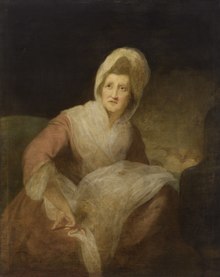 Patience in later years
Patience in later years
Her boisterousness resulted in the nickname "The Promethean Modeler." Despite this, or because of it, she became quite a celebrity in 18th-century London. But not everyone was amused with her antics. Abigail Adams was taken aback by her overfamiliarity and lack of modesty, deeming her “the queen of sluts” in one letter.
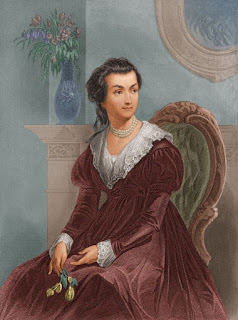 Abigail Adams
Abigail Adams
She is said to have softened the wax by rubbing it against the warmth of her body under her apron. Patience often did this suggestively, both amusing and irritating her subjects. But her work was excellent, and more importantly, very popular. She was commissioned to model King George III, and eventually other members of British royalty and nobility. Even the royals were treated to her style of casual banter and it was reported she called them by their first names while they sat for her.
 British newspaper cartoon
British newspaper cartoon
Despite her dependence on the largess and patronage of British society, Patience Wright remained an American and a patriot at that. She was quite outspoken for the cause of the patriots, often antagonizing her customers. Patience also took action. American prisoners of war held in Britain lived in sub-human conditions. She raised money to support them. She met with pro-American politicians such as the activist Lord George Gordon and Benjamin West, who would visit her workshop to talk about the rebel cause.
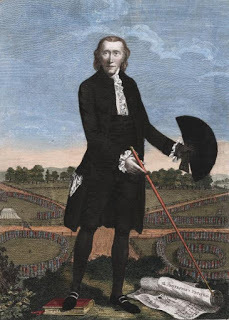 Lord George Gordon
Lord George GordonSculptress Spy
But did this make her a spy? Maybe yes, maybe no, but she had an active correspondence with prominent Americans and most likely provided them “nuggets” gleaned from her wealthy and high-placed connections during the early years of the American revolution. She corresponded with Benjamin Franklin and John Jay, both key figures in the diplomatic side of the war. Patience also wrote letters to Pennsylvania politician John Dickinson describing the British Army's preparations in England. Tales abound of her sending sculpted wax figures embedded with secret notes to her sister in Philadelphia. But this is not substantiated.
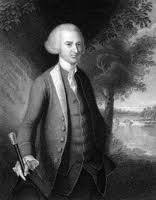 John DickinsonA Rapid Fall
John DickinsonA Rapid FallWright eventually fell from royal favor as a result of her open support for the colonial cause, especially when she reportedly scolded the king and queen after the battles of Lexington and Concord. Eventually, opposition to her patriot sentiments forced her to move to Paris. During her two years there she crafted a wax model of Benjamin Franklin but was unable to establish a waxwork. In 1782, Patience sailed back across the English Channel.
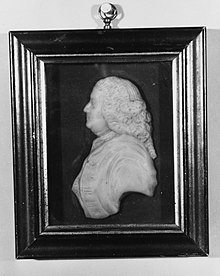 Patience Wright's Bust of Franklin
Patience Wright's Bust of Franklin
Back in London, Patience moved into the St. James’s Square home of her daughter, Phoebe, who was married to painter John Hoppner. In 1783, Wright made firm plans to return to America and sculpt wax busts of General George Washington and the other Founders.
 John Jay
John Jay
As she wrote to founder and diplomat John Jay, “I wish for nothing more than to finish the portraits in wax busts of all you worthy heros that have done honour to themselves and their Company.”
The sculptor-patriot made plans to sail no later than 1786. Unfortunately, she had a serious fall and died of complications on 23 March of that year. Patience was buried in London but sadly, her gravesite is unknown.
America’s First SculptressFew of Patience Wright’s works survive today, largely because of the fragility of the wax medium. Wax figures were considered “low art” in comparison to bronze or plaster sculptures. Still, a full-length figure of William Pitt, Lord Chatham, is on display in Westminster Abbey. And some attribute a profile of Admiral Richard Howe in the Newark Museum to her.
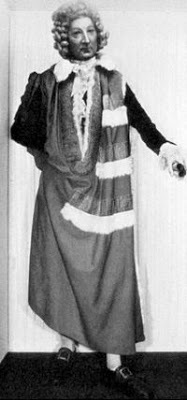 Patience Wright's William Pitt statue
Patience Wright's William Pitt statue
Her subjects included Benjamin Franklin, female-soldier Deborah Sampson, and of course, the King and Queen of England. But she is known to have also made sculptures of Lord Lyttelton, Thomas Penn, and Charles James Fox. In all, she is credited with molding some fifty-five major works but her only confirmed work is the William Pitt, Lord Chatham figure.
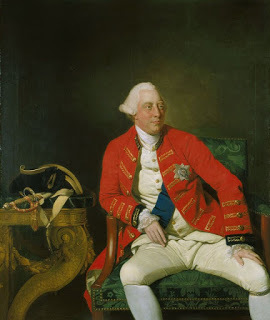 King George III sat for Patience
King George III sat for Patience
Patience Lovell Wright was a remarkable character in an age of remarkable characters. Wife, mother, businesswoman, artist, political activist, and spy. Yes, I am going out on the proverbial limb but her obstinate and willful character, combined with her patriotism, lends itself to the risk-taking needed for espionage. Hiding in plain sight, who would guess she was sending reports to Paris and Philadelphia? Her folksy brashness and subtle sexuality were sure to keep people off guard, enabling her more serious work to go undetected. Yet her artistic talents were real and impressive. And I have little doubt, had she made it home, her artistic accomplishments would have gained new heights and would be celebrated to this day.
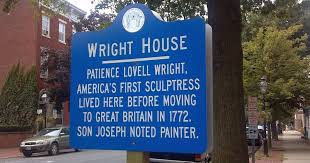 Bordentown Home
Bordentown Home
May 30, 2021
Nothing Could Be Finer
Tar Heel Travelers
As Yankee Doodle Spies/RevWarTales matures, I plan to include more "news you can use." In my various forays across the world wide web during this past year of lockdowns, I stumbled across a website that I found both interesting, and useful - The American Revolution Tour of North Carolina, which can be found at https://amrevnc.com/
Throw away that Michelin guide, gas station map, and even your favorite GPS app (okay – keep that one), The American Revolution Tour of North Carolina can help you find, explore and visit the state's heritage sites. From the up-country Regulators to the low-country planters, this site helps guide you across the ground where the first patriots and their loyal opposition once gathered, marched, and clashed.
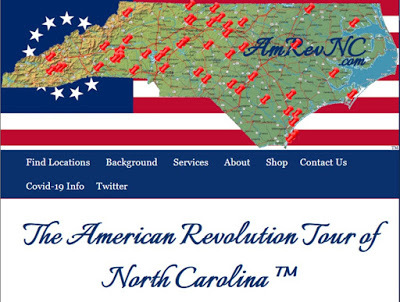 (Courtesy of AmRevNC, LLC)
(Courtesy of AmRevNC, LLC)
Growing up in New York, my early exposure to the American Revolution focused on the northeast and mid-Atlantic. And for lots of good reasons. For one, that is where the conflict erupted in full and where General George Washington and many other illustrious and not so illustrious generals in the pantheon of Rev War leaders fought.
Stalemate in the NorthBut by 1779, the war in the north had reached a form of stasis. General Washington was relegated to a war of watch and wait. Watch the British garrisoned around New York City. Wait for the French to marshal enough men and ships to help retake the grand prize he lost in 1776. By this time, the British had replaced Lord Howe with Sir Henry Clinton as commander-in-chief.
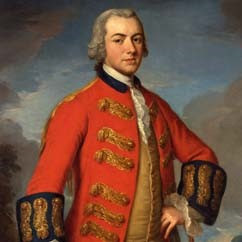 Sir Henry Clinton
Sir Henry Clinton
But they found occupying the American capital in Philadelphia no longer practical. One of Sir Henry’s first actions was to abandon the city and retrograde back to New York. With total naval supremacy, the New York area would be easy enough to hold. But the north was in an overall state of quiet, except for raids and probing actions.
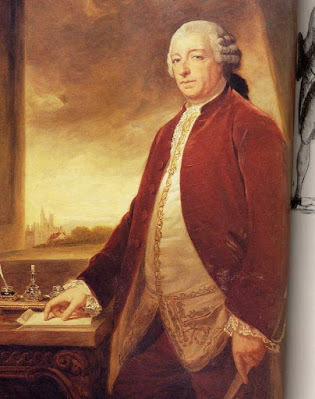 Lord Germain
Lord Germain
The British saw an opportunity in this, but only if they could move quickly before the French, and others, had fully engaged. Knowing the West Indies would become the more critical area of operations as the French tried to retake lost islands, Lord George Germain, Secretary of State for the Colonies, shifted the center of gravity (my words) south. The so-called “Southern Strategy” was born.
Southern StrategyThe Loyalists in the south convinced the British high command that there was widespread support for the crown in the Carolinas. By shifting forces there and leveraging that support, the British could divide the Americans and perhaps keep the southern colonies in the empire. This had the added benefit of the south’s proximity to the more valuable (in contemporary British minds) West Indies.
It was a good strategy. Except that the support for the crown was not overwhelming and a series of British missteps and American propaganda soon turned the south into a prairie fire of combat. Scores of battles, large and small, mostly small, raged from the end of 1779 through the closing months of the war.
This became a civil war with the British caught in the middle. And the fighting was bitter and personal. Friend against friend. Family against family. In the end, the patriots outfought the Loyalists. That made the costly victories of the British futile in pursuit of their goal of subduing the Carolinas. You might not say the Americans won the war in the south. But you can say the British lost it there.
A Valuable ToolAlthough this website is focused on North Carlina, it also includes information of a broader sort. For example, the excellent war timeline includes activities, not in North Carolina. But of course, the Tar Heel events are hyperlinked to even more information. A click brings you deeper into the subject area. Fabulous visuals, maps, travel information, the back-story, tips on key events. It is all there for the traveler to use. And for those who want to know more, each section provides a very comprehensive bibliography of books, periodicals, and websites that provide deeper dives into the subject.
 AmRevNC Timeline (Courtesy of AmRevNC, LLC)
AmRevNC Timeline (Courtesy of AmRevNC, LLC)Geography is Everything
Although this is a history website, history is merely a set of yarns without geography. Everything has to happen someplace.
The site offers you the choice of:
Finding all locations on a map. Finding them by county. Or browsing for them by region of the state. These are all collected into driving tours. They have day trips and multi-day trips scoped out for you. Here is the regional breakdown:
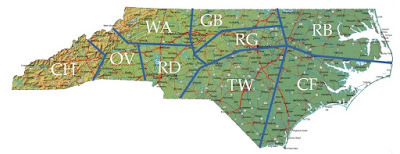
Geography is everything: Tours by geographic region (Courtesy of AmRevNC, LLC)
Having lived in North Carolina, I can tell you the historic traveler can see amazing natural beauty while exploring battlefields, cemeteries, plantations, farms, and monuments. Climb the rugged mountains in the west, cruise over the rolling piedmont hills, and feel the sultry woods, fields, and wetlands along the Atlantic coast.
 Enjoy some of the nation's finest natural beauty while exploring the Am Rev
Enjoy some of the nation's finest natural beauty while exploring the Am Rev
This site makes it easy.
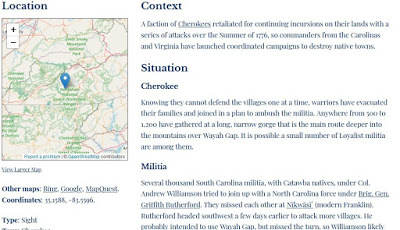 Geography is everything: Driving tours map (Courtesy of AmRevNC, LLC)
Geography is everything: Driving tours map (Courtesy of AmRevNC, LLC)
In one case, I clicked into the Wachovia regional tour and selected Shallow Ford. The Yankee Doodle Spies Blog featured a post on this battle some years back. It was a skirmish between North Carolina and Virginia militia and a larger force of Loyalists. I wish I had this resource when I was researching my blog post. I was very pleasantly surprised with the visualization, the story told, and the ease of doing a virtual “staff ride” even before one spends gas money for the actual visit. A great online experience. There are nice photos of key locations in the battle.
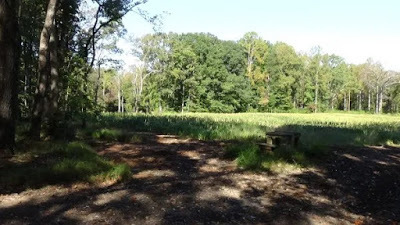 View from the Tory position in the second phase of Shallow Ford Skirmish (Courtesy of AmRevNC, LLC)
View from the Tory position in the second phase of Shallow Ford Skirmish (Courtesy of AmRevNC, LLC)
The site included excellent map graphics of the battle. They portray your tour stops juxtaposed on the arrows of advance and retreat.
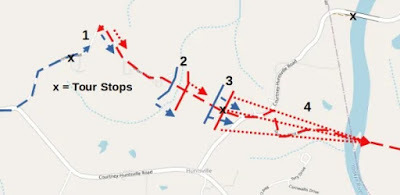 Shallow Ford Battle Map (Courtesy of AmRevNC, LLC)The Gift Shop
Shallow Ford Battle Map (Courtesy of AmRevNC, LLC)The Gift ShopA nice touch to the site is the online gift shop. It includes a variety of “swag” for NC Am Rev aficionados. That currently includes such basics as tee shirts, mugs, and tote bags. One suspects the list of items will grow over time, perhaps including books and prints.
 Some AmRevNC Swag (Courtesy of AmRevNC, LLC)
Some AmRevNC Swag (Courtesy of AmRevNC, LLC)
I reached out to the webmaster and site developer, Jim Morgan, and asked him how he came up with the idea. Curiously, he said it was based on a lie! Or in any event, faulty information in a book on a skirmish called Pyle’s Defeat. After traveling out to the venue, he discovered the book had it wrong! Jim, who holds a Master's in Journalism and was once a professional writer, decided to fill a void and went to work doing research, writing, and initial web design. It was time well spent. Jim also put the site together with the help of an excellent support staff who do site investigation, research, editing, and web design. A complete list of his excellent team is included in the site credits.
 AmRevNC.com Pyle's Defeat image: Sunken remains of the Hillsborough-Salisbury Road not open to the public
AmRevNC.com Pyle's Defeat image: Sunken remains of the Hillsborough-Salisbury Road not open to the public
Jim launched the site on 5 March after a year of 70-hour weeks and logging some 8,100 miles. Although well beyond the beta phase, Jim advises the site is continually updated as new information is discovered and old information is clarified. They actively seek site users to comment and point out things for correction or improvement - sort of an NC Rev version of Wikipedia. Would that each of the 13 colonies/states had someone like Jim Morgan help bring the American Revolution to them. Or should I say, bring them to the American Revolution? With this site, you can do both.
Hit the Road, JackWith people tearing off their masks and itching to get on the road this summer, I cannot think of a better way to enjoy it than to visit the many American Revolutionary War sites at the national, state, and local park level. This website is the perfect tool for anyone wishing to focus on the struggle in the Tar Heel State.
Your journey in time and space begins with just one click: https://amrevnc.com/about-this-site/

So what are you waiting for? This website is a must for historic travelers. It provides a great tool for planning, getting to, and visiting some of the most well-known, and more importantly, not-so-well-known venues in America’s eight-year struggle for independence. Nothing could be finer than to be in Am Rev North Carolina. Any time.
April 25, 2021
First to Fall Part 2: First Hero
Brigadier General Richard Montgomery pulled at his leather glove as the line of poorly fed and armed men marched north. The winds were picking up and the skies looked like slate. His gaze shifted to the dense forests to the north – Canada. We must strike quickly or these lads will leave their bones here.
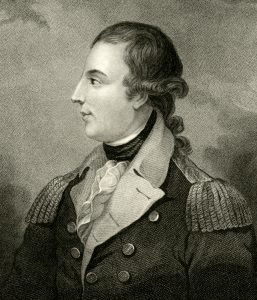 Brigadier General Richard Montgomery
Brigadier General Richard Montgomery
On 4 September, Schuyler joined Montgomery with an additional 800 men. So now he had 2,000 poorly trained and equipped men. And Schuyler was ill. Still, the old new Yorker ordered the army to advance to a small island on the Richelieu River called Île aux Noix. There was little time to waste, so on 6 Sep Montgomery led a force north to their first objective, Fort St Johns, which protected the approach to Montreal. Paddles and oars skimmed the dark waters, each stroke taking the army, and Montgomery, closer to their fate. They carried more than bullets in their pouches. Schuyler, whose health was poor and would not be able to lead the expedition, had drafted a proclamation declaring the Canadians "Friends and Countrymen", and beseeching their support in driving the British from the territory. They would be disappointed in this hope. Montgomery’s probing attack failed. Although he was able to drive off an ambush force of some 100 Indians under Captain Matthew Mead, Schuyler feared the fort could not be taken by storm and recalled Montgomery to the isle, which the Americans fortified.
 Area of Operations around Montreal
Area of Operations around Montreal
Montgomery decided to make another go at Fort St. Johns, but this attack fared no better. In a comedy of errors, the two pincers of the American assault stumbled into each other in the dark and soggy woods. Each thought they had encountered the British and both forces fled. A blazing mad Montgomery was able to stop the flight and redirect them at the fort.
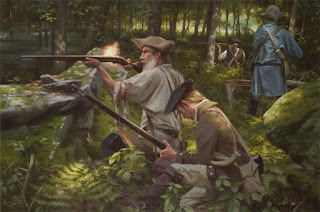
His men advanced under withering British grapeshot fire and the assault on the British breastworks was driven back. Montgomery planned another attack on the fort. But half the New England troops fled. Montgomery, believing his force could no longer take the fort, retreated to Île aux Noix. When Schuyler’s illness forced him to return to Fort Ticonderoga, command of the late-to-start and ill-equipped operation was now his.
On September 16, Montgomery launched another expedition against the British fort. This time he had 1,400 men plus a naval component consisting of two small ships and ten Bateaux with 350 troops. The latter would counter the HMS Royal Savage. Montgomery arrived with the main force the following day. A month-long siege began, with the defenders outmanned and the attackers outgunned. The British garrison of 725 men was commanded by Major Charles Preston, who just three years earlier was Montgomery's superior officer in the British Army. After initial skirmishing, Montgomery set about to besiege the fort. It was slow going. Montgomery was everywhere at once, encouraging the building of siege lines and himself often coming under fire.
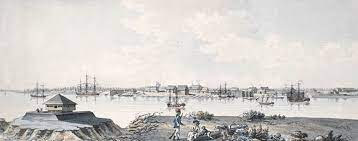 Fort St. John
Fort St. John
On 22 September, the fiery general was inspecting the breastworks when a cannon shot from the fort flew by, tearing his coattails and sending him tumbling off. By luck and dexterity, Montgomery managed to land on his feet. His men were watching and all were impressed by his Sang Froid. Their commander was a man of steel nerves. However, by early October, they had still not closed the ring on the fort, despite moving in more guns. A battery did sink HMS Royal Savage but Montgomery’s forces were still outgunned in most places.
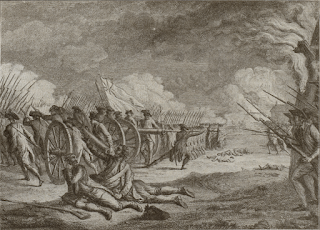
In mid-October, James Livingston, who was a relative of Janet Montgomery recommended Montgomery try attacking nearby Fort Chambly, a weaker post than St. John. He agreed and launched a night attack ten miles down the river and in two days the fort surrendered 83 men and tons of invaluable powder. But the biggest prize was the colors of the 7th Royal Fusiliers, which he shipped off to the bedridden Schuyler – the first British battle flag to fall into American hands.
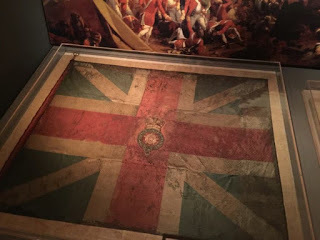 The King's Colors of the 7th Royal Fusiliers
The King's Colors of the 7th Royal Fusiliers
This raised morale and Montgomery was able to get his men to tighten the works around Fort St. John. They were also able to repulse a relief force sent from Montreal by General Guy Carleton, the British commander in Canada. By 1 November, the new batteries placed north of the fort completed the ring. They began a bombardment that smashed walls and buildings, harming few but eroding the morale of the defenders. As darkness descended on the combatants, Montgomery directed a cease-fire and sent in a flag of truce. During the night, the Americans intercepted a dispatch from Carleton ordering Major Preston to continue his defense. The next day the fort surrendered with full military honors and its garrison marched off to imprisonment. One wonders what would have transpired if the message got through.
MontrealMontgomery’s first big prize was now within his grasp. But the elements and the ground provided the British a capable ally. His men trudged over rugged terrain covered with ice and snow. An early winter storm made the going even tougher. He urged his men on, Carleton and his army were almost in the bag. When he learned of a British plan to slip away, he sent a detachment to Sorrel. After brief fighting, the British withdrew. Smoke spiraling from the chimneys on Montreal greeted Montgomery’s men as they closed on the city. A surrender demand failed, however, and while negotiations dragged on, Carleton was able to slip down the St. Lawrence River to the safety of Quebec. On 13 November, Montgomery’s weary men entered a city bereft of defenders - a pyrrhic victory.
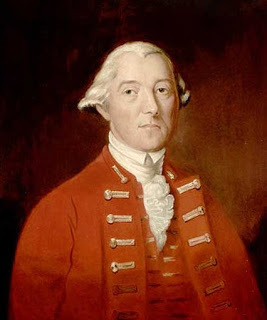 Guy Carleton
Guy CarletonBack in Montreal, Montgomery insisted the captured British prisoners be treated kindly. After all, many were not long before his comrades in arms. But some of his own officers were disgruntled by this. Montgomery was dismayed at another show of indiscipline and only remonstrances from the commander-in-chief prevented his resignation.
QuebecDetermined to conclude the campaign, Montgomery sailed to Quebec City on 28 November with 300 of his best men. Four days later he joined forces with Benedict Arnold's surviving men at Pointe aux Trembles, just upriver from Quebec. Montgomery assumed command of both forces and his first act was to provide needed clothing and supplies to the worn-out “rabble in arms” that marched through the Maine wilderness. But winter was closing its arms around Canada and he had to move quickly. The following day his combined force moved down river and surrounded Quebec. On 7 December he sent a letter with an ultimatum but it was burned by Carleton. Then Montgomery tried to woo the Canadians to the cause, but his envoy was arrested. Desperate to appeal to Les Habitants (the locals), he had his proclamation fired over the city wall with bows and arrows. But they remained loyal to their new masters.
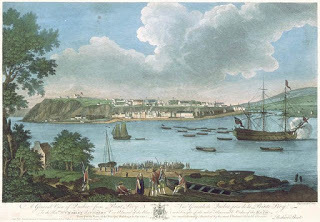 Quebec City was the Key to Canada
Quebec City was the Key to Canada
Now Montgomery had to do the dirty work of a siege. Several mortars began shelling the city but their shells caused little damage. Undaunted, Montgomery moved another battery onto the Plains of Abraham, the site of the battle that sealed the city's fate in the French and Indian War. The guns were closer to the walls but were also exposed. Still, by 15 December, Montgomery had his batteries in position. Anxious for closure, he once more asked for Carleton’s surrender. When Carleton refused, Montgomery’s batteries opened fire. The guns failed to make an impact and were immediately threatened by effective British counter-battery fire. He was forced to order them back.
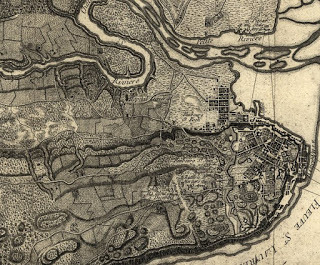 Quebec City and Environs
Quebec City and Environs
With supplies dwindling, morale weakening, and winter upon them, Montgomery had no choice but to storm the city. He decided to assault the Lower Town district (Saint-Roch), on the bank of the Saint Lawrence while Arnold would storm the powerful Cape Diamond Bastion. He planned the attack during a stormy night, hoping it would cloak their attack from British eyes. An attack planned for 27 December was scrubbed when the weather cleared. He was forced to revise his plans when someone deserted to the British and exposed his plans.
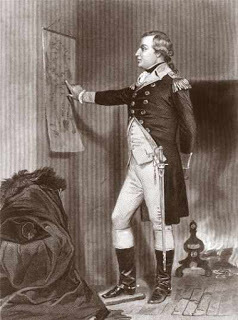 Montgomery's situation required careful planning and flexibility
Montgomery's situation required careful planning and flexibility
Montgomery adjusted. He would try a two-prong attack on the Lower Town, from the south, and Arnold from the north. To confuse the British, Montgomery employed a deception operation. He ordered the 1st Canadian Regiment (locals who joined the American cause) to fire at one of the gates while a detachment would engage the defenders at Cape Diamond Bastion. The signal for the attack was rocket fire. Montgomery’s lackluster artillery would bombard the city during the feint attacks. This was a bold and desperate gambit. One Montgomery did not want to make, but he had no choice. As George Washington would face a year later, expiring enlistments were sapping the army, and on 1 January, many would be gone.
A Night to Remember, and ForgetMontgomery got his second snowstorm on the night of 30 December. He quickly issued the order. Shivering, but now energized, the Americans assembled in the wind and snow. The night was cold, dark, and intense. Wind howling and snow swirling. Where was the signal? At 4 am, an orange burst lit the sky. Boot steps muffled by the wind and snow, his men made their way to the lower town. But the British were alerted by the rockets and the walls were well-manned.
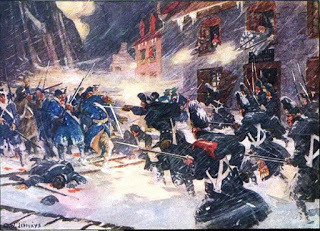 Night attack in a snowstorm
Night attack in a snowstorm
With their general at the van, the Americans edged down the steep and slippery cliffs and arrived just under the city walls. As though they did not have enough obstacles, a palisade at the edge of the Lower Town now blocked their way! Axemen ran to the fore and began chopping through. Then Montgomery personally led his van through the opening. Unknown to Montgomery, he was now a major general, promoted by Congress on 9 December for the victories at St. Johns and Montreal. Eyeing a two-story blockhouse barring their way, he had not a moment to lose, nor a moment’s hesitation. He drew his sword and led the troops toward it, shouting, "Come on, my good soldiers, your general calls upon you to come on."
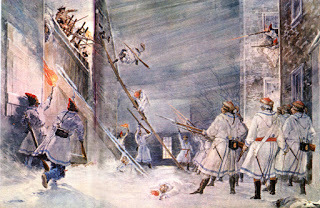 Quebec's defenders proved formidable
Quebec's defenders proved formidable
The desperate men gripped their muskets tightly and stepped forward. Some fifty yards away, equally determined Canadian militia and British sailors in the blockhouse unleashed a torrent of musket balls and grapeshot. Montgomery was struck by grapeshot in the head and both of his thighs and died on the spot. The murderous fire took down two of his captains.
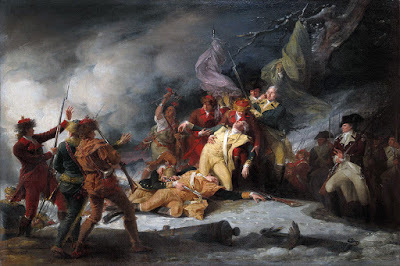 Death of Montgomery
Death of Montgomery
The attack crumbled with Montgomery’s death. The Americans retreated in disorder. A staff officer named Aaron Burr tried to drag Montgomery’s body back but failed. Meanwhile, Benedict Arnold's attack, which started well, also collapsed when Arnold was struck down with a ball in his leg. Many of his men were forced to ground arms before the British bayonets, including Daniel Morgan. With the guns suddenly still, the howling wind and snow sounded the end of the effort to join Canada to the American cause.
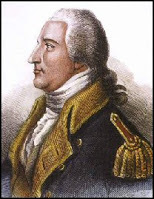 Benedict Arnold
Benedict Arnold
Montgomery was esteemed by the British for his prior service and his treatment of the prisoners at Montreal. Carleton had him buried simply but honorably on 4 January. Some of his men, now prisoners, watched their beloved and heroic general at the solemn interment. Meanwhile Arnold, leg bandaged, took command of the shattered army. His efforts to save the lost cause would prove heroic and prodigious but futile.
First Hero – First MonumentNews of Richard Montgomery’s death was a blow to the Northern Department. Schuler wrote, "My amiable friend, the gallant Montgomery, is no more; the brave Arnold is wounded; and we have met a severe check, in an unsuccessful attempt on Quebec. May Heaven be graciously pleased that the misfortune may terminate here." For a time, news of his death was hushed up to delay the blow to morale that would follow.
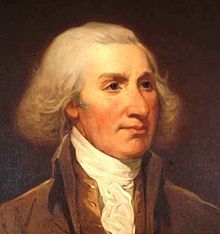 Phillip Schuyler
Phillip Schuyler
Washington was dismayed at the loss. So struck by Montgomery’s valiant death, Congress commissioned a monument to him and held a memorial service. He was celebrated as a hero throughout the colonies – perhaps the nation’s first national hero.
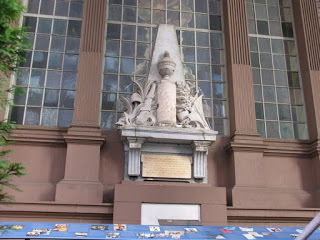 The Montgomery Monument
The Montgomery Monument
Significantly, Montgomery's death was mourned in Britain and his former Whig allies used this death of a Briton to assail British policy. British Prime Minister Lord North recognized his qualities as a man but condemned him as a rebel. But many of the London papers actually paid tribute to Montgomery.
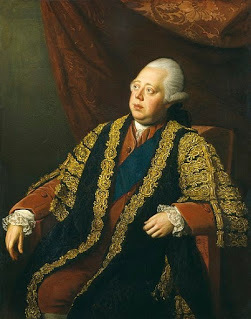 Lord North
Lord North
Montgomery’s widow Janet would protect his legacy for the rest of her life. She moved to the house near Rhinebeck started with such hope before the war. She turned down a marriage proposal by former Continental general and British officer Horatio Gates. This was significant in a society where widows typically remarried.
Final FarewellIn 1818, Governor Stephen van Rensselaer of New York had Montgomery's body moved to New York. Some 5,000 mourners made up his funeral procession and on 8 July he was laid to rest for the last time right next to the Montgomery monument at St. Paul’s church. The ceremony gave some closure to Janet Montgomery, who was pleased with the honors bestowed on the soldier she loved.
In a final thought, the city of Montgomery, Alabama, named for America's first hero, unveiled a statue of its namesake in 2019 as part of its bicentennial celebration. It is somehow moving that a man who perished in the bitter cold of the north would be recognized by citizens in the deep south.
 Montgomery statue in Alabama
Montgomery statue in Alabama
March 28, 2021
First to fall: Richard Montgomery
Swirling snow broke the cold night’s darkness. Desperately cold and weary men stood in the courtyard, their nervous eyes scanning the dark walls for the enemy they knew was waiting. Their leader stepped forward. Eyeing a two-story blockhouse barring their way, he had not a moment to lose, nor a moment’s hesitation. He drew his sword and led the troops toward it, shouting, "Come on, my good soldiers, your general calls upon you to come on."
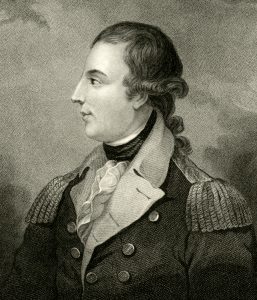 Richard Montgomery
Richard Montgomery
The Continental Army had several general officers die in or as a direct result of combat during the American War for Independence. Generals High Mercer, Johann de Kalb, and Kazimierz Pulaski often come to mind. David Wooster not so much. And one, Major General Joseph Warren, curiously fell serving as a private soldier at Bunker Hill in 1775. Although Warren was a militia general and not leading troops, he deserves to be named. But who was the first American general to fall at the head of a body of American troops?
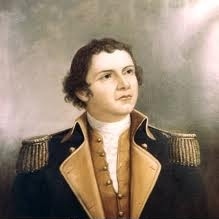 Hugh Mercer: most celebrated fallen general
Hugh Mercer: most celebrated fallen general
Not surprisingly, after all, we are in the month of the Feast of Saint Patrick, he was a son of Ireland by the name of Richard Montgomery. Born at Swords, County Dublin, Richard Montgomery entered the world of Ulster-Scots privilege on 2 December 1738. The family roots were in Donegal but his wing of the Montgomery clan was now ensconced in the Dublin-London axis. His father was a member of parliament. His brothers would also engage in the then-common British mix of politics and military service. Young Richard would also take that route, but with some interesting twists and turns along the way. Typical of his class, he entered Trinity College in Dublin but left before finishing to accept a commission in the 17th regiment of Foot purchased by his father in 1756. And why not? What better way to make a name and advance than following the colors?
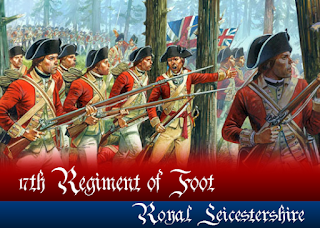
The French and Indian War (Seven Years War) became the training ground for Montgomery, as it would for many on both sides who would fight in the American war for Independence. Ensign Montgomery was about to enter a whirlwind of action and adventure. His regiment was shipped to Halifax, Nova Scotia where it joined a large British army marshaling for in the siege of Louisbourg, a fortress on the Atlantic coast of Cape Breton Island. This massive fort had played a key role in all the struggles for North America. Now, two of Britain’s best generals, James Abercromby and Jeffery Amherst had the forces to do it. On June 8, 1758, the attack began. Montgomery landed on the beach under heavy fire and ordered his troops to advance with fixed bayonets. The French outposts were collapsed and the siege began. The siege was successful and General Amherst was impressed by Montgomery's action during the siege and promoted him to lieutenant.
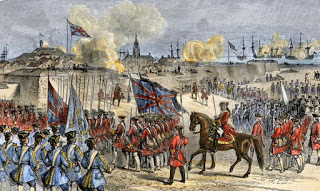 Siege of Louisbourg
Siege of Louisbourg
The Louisbourg campaign was followed by serious fighting in the wilds of central New York the following month and the 17th and Montgomery were in the thick of it. The waterways (Lake Champlain and George, the Richelieu, and Hudson Rand Mohawk Rivers) between central New York and Canada provided a strategic thoroughfare through the mountains. Fans of The Last of the Mohicans can appreciate the setting: rugged slopes, large, dark, and deep lakes, swollen rivers, and verdant valleys. The key installations of Fort Carillon (Ticonderoga) and Crown Point became the fulcrum of death. Yet it proved a beautiful place for men to blast and carve each other to pieces. Montgomery’s skills were honed here. He learned patrolling, picketing, and close combat.
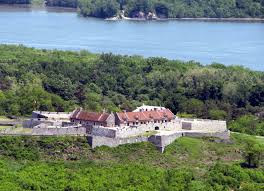 Fort Ticonderoga
Fort Ticonderoga
The British would eventually force the French to withdraw to the northern tip of Lake Champlain. The strategic advantage was theirs. The 17th regiment spent 1759 in the Mohawk Valley under the command of General Monkton, who appointed Montgomery adjutant on 15 May - a sure mark of his distinction and potential. In August 1760, the 17th regiment set out for Montreal as part of a three-pronged attack to take the city. Montgomery’s regiment seized Isle aux Noix and Fort Chambly and then joined the British regiments outside of Montreal, which the Marquis de Vaudreuil, Canada's French governor, soon surrendered. But the war was far from over.
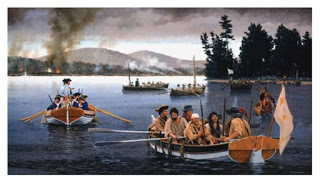 French withdrawing north on Lake Champlain
French withdrawing north on Lake Champlain
The fall of Montreal gave the British control of North America, so now they could turn their attention to the West Indies, where there were valuable sugar islands to be had. The 17th sailed south after Canada was secured. There were French and Spanish islands to conquer. The British seized a beachhead on the key French island of Martinique and then unleashed an offensive that overran the French outer defenses. The French survivors went scurrying into the capital, Fort Royal. This time, before the British could even launch an assault, the French surrendered. The rest of the French islands of the French West Indies, Grenada, Saint Lucia, and Saint Vincent, quickly followed. On 6 May 1762, Lieutenant Colonel John Campbell promoted Montgomery to captain and gave him command of a company in the 17th.
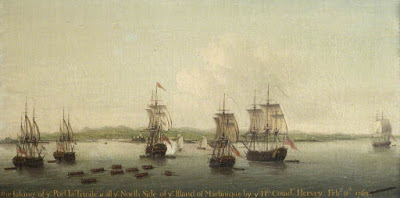 The British invasion of Martinique
The British invasion of Martinique
Now Britain could turn on France's ally, Spain. Since Spanish Cuba controlled the approaches to the Indies and North America, it was a prime target. On June 6, British forces arrived off the shore of Havana. Before them stood Moro Fort, the key to the Spanish defense of the city. It had to be taken. British battleships bombarded the fort, silencing all but two Spanish guns. On July 30, Captain Montgomery and the 17th Foot stormed and captured the fort. In late August 1762, Montgomery and the 17th Foot were sent to New York. The long and bloody war ended with the Treaty of Paris on February 10, 1763. At the time, the British triumph was resounding: a world empire! Few could imagine the treaty would lead to even more conflict, political unrest, and a longer war.
Pontiac's War
Things did not quiet down in North America after France’s surrender. Angered the French ceded their lands to the British and the land-hungry colonists, the tribes exploded into action in April 1763. The Ottawa chief, Pontiac, organized 18 tribes in a deluge of attacks on British military and civilian settlements. Eight British forts fell and two more were abandoned. General Amherst ordered the 17th to Albany in June 1763 to assist in combating the outbreak of hostilities. This would bring experience in Indian-fighting but more importantly, the beginning of a life-long love.
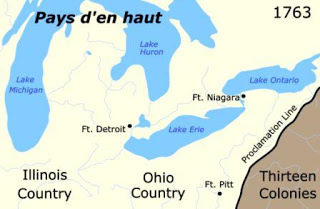 Pontiac's War threatened Britain's new western lands
Pontiac's War threatened Britain's new western lands
Sailing up the North River to Albany, Montgomery’s vessel ran aground near Clermont Manor, NY, home of the politically powerful Livingston family. The family entertained the ship's officers while their ship was being repaired. This was serendipity for the bachelor Montgomery, who met Janet, the 20-year-old daughter of wealthy and powerful Robert Livingston. It is unclear if love bloomed at first sight, but Janet noted Montgomery was not with the same party of officers when they returned to New York following the campaign. So the young Irishman clearly made an impression.
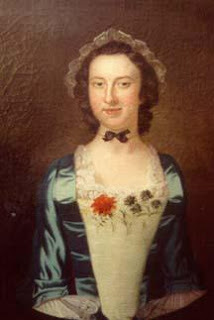 Janet Livingston
Janet Livingston
The 17th spent 1764 in garrison duty at Fort Stanwix. While there, Montgomery applied to Colonel Campbell and General Thomas Gage to return to England on leave to recover from ill-health that resulted from service in the Indies. Gage approved his leave, but on the proviso that he could go only after the upcoming expedition.
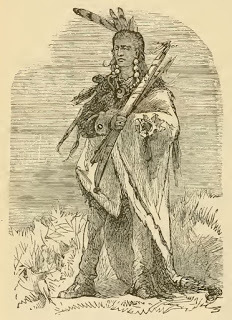 Ottawa War Chief Pontiac
Ottawa War Chief Pontiac
In July, Montgomery’s regiment joined John Bradstreet’s expedition to Fort Niagara, providing security for Royal Indian Agent Sir William Johnson’s conference with the Great Lakes tribes. By August, the regiment was marched through woods and fields to Fort Detroit, the target of Pontiac’s attacks. Montgomery’s company was put to work moving earth, logs, and stone to improve the beleaguered fort’s defense works. His leave was still on hold.
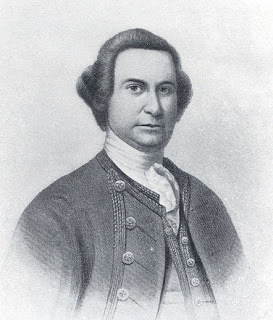 Sir William Johnson
Sir William Johnson
The following month, Montgomery got a break, General Bradstreet took him to Sandusky, for a meeting with the Shawnee and the Delawares. After successful parleys with the Iroquois, Bradstreet released Montgomery, who would deliver dispatches to Gage before departing for England. Back in London, Montgomery was soon caught up in political circles.
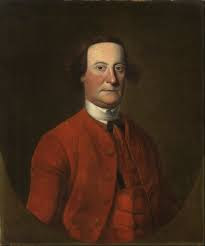 General John Bradstreet
General John Bradstreet
His health restored, he associated with Whig Members of Parliament, who generally supported the colonists in their demands for more political freedom. Several of their leading lights, Isaac Barre, Edmund Burke, and Charles James Fox befriended the young officer. Political discussions with these and others brought him to question the government policies. When the 17th Foot returned to England in 1768, he was put in charge of recruiting men to fill the ranks depleted by war and disease. Montgomery suffered romantically, however, when an arranged engagement was ended because his fiancé proved unfaithful.
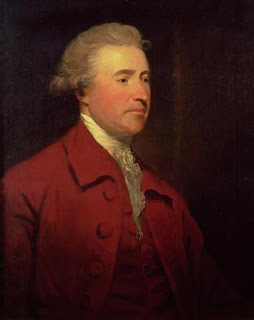 Edmund Burke
Edmund Burke
After months and years of action in the field, it is common for the humdrum of the peacetime army to grate on men of ambition. So it was for Montgomery. In 1771, he learned he was passed over for promotion, possibly due to his Whig politics. He sold his commission for about £1,500 in 1772 and sailed for America in July. Spurned by a woman and the army, Montgomery had sworn to never marry or take up arms again. His goal was to become a gentleman farmer in the new world.
Colonial LifeMontgomery settled in a part of America he knew well: New York. Perhaps recalling his interlude on the Hudson, Montgomery renewed his acquaintance with the wealthy young Janet Livingston. He bought a farm at King's Bridge, 13 miles north of New York City. While adjusting to his surroundings, Montgomery's "renewed acquaintance" blossomed into something more. Janet later recounted that his "politeness led him to make me a visit." The courtship led to an engagement and the following July the confirmed bachelor was in wedded bliss.
 Montgomery settled along the North (Hudson) River
Montgomery settled along the North (Hudson) River
Montgomery leased his farm to a tenant and settled in a cottage gifted to them by Janet’s grandfather, Judge Beekman. The cottage was situated on the Post Road in Rhinebeck. Montgomery purchased some of the surrounding lands and began building out the farmstead and laying the foundation for a larger home called "Grasmere." Montgomery told Janet he was never happier but insisted it could not last. For her part, Janet had a dream in which Montgomery was killed in a duel by his brother. He was resolved to short-lived happiness and insisted it be left to God. So the couple enjoyed their happiness. But not for long.
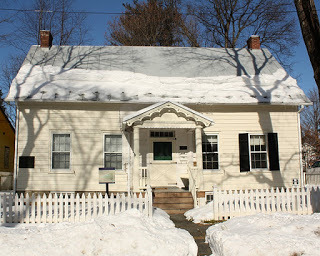 The Montgomery Cottage
The Montgomery Cottage
As the colonies began to question Parliament’s authority, political unrest turned to resistance. By 1775, Montgomery began to turn against the British government, which he viewed as oppressive. Being tied to one of New York’s most patriotic families did not hurt either. The former British Army captain now saw himself as an American instead of an Englishman.
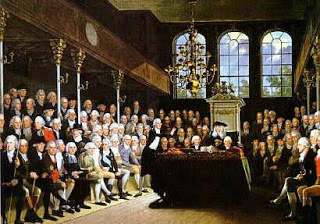 Parliament
Parliament
In May, Montgomery represented Dutchess County in New York’s new Provincial Congress. Although Montgomery had not sought political involvement, he had quickly become a well-respected local leader and was obliged to attend the session in New York City, some 80 miles south of Rhinebeck.
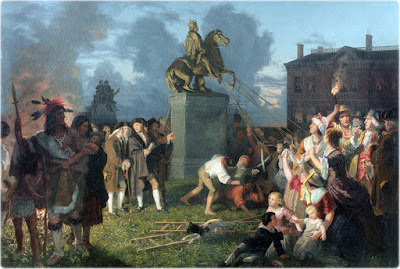 New York was rife with political strife
New York was rife with political strife
At the first session in May, Montgomery joined the other 97 delegates, in approving a resolution legitimizing its authority. Yet he was still only a “moderate" patriot. Although he viewed the British Government wrong in its policies, he still wanted honorable reconciliation. But the faction still loyal to George III was on the wane. Few of those delegates even showed. But Montgomery stayed. He would fight for his rights as a Briton and an American. Because of his military experience, Montgomery was placed on a committee charged with planning defense works around New York and organizing and supplying the new provincial militia.
War for IndependenceAfter the appointment of George Washington as Commander-in-Chief of the newly formed Continental Army on June 15, 1775, the Second Continental Congress asked the New York Provincial Government to select two men for service in the army. One would be a major general, the other a brigadier general. The assembly favored wealthy and well-connected Philip Schuyler as the major general, despite his lack of military experience. The more highly-qualified Montgomery was made a brigadier general. Montgomery expressed reluctance to return to military life. Perhaps his premonition returned to haunt him. But he agreed to serve.
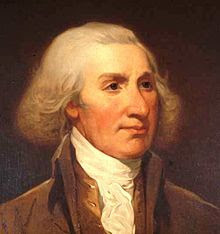 Phillip Schuyler
Phillip Schuyler
Montgomery's thoughts on serving are expressed in a letter, "The Congress having done me the honor of electing me brigadier-general in their service, is an event which must put an end, for a while, perhaps forever, to the quiet scheme of life I had prescribed for myself; for, though entirely unexpected and undesired by me, the will of an oppressed people, compelled to choose between liberty and slavery, must be obeyed."
America Turns NorthIn June 1775, newly proclaimed commander-in-chief, General George Washington assigned Montgomery as deputy commander under Phillip Schuyler who received orders to invade Quebec and bring Canada into the war on the American side. A force was assembled at Fort Ticonderoga and Schuyler left to take command of the army leaving Montgomery in Albany to make final arrangements for the invasion. Janet followed him as far north as Saratoga, where he promised he would do his duty and preserve his honor.
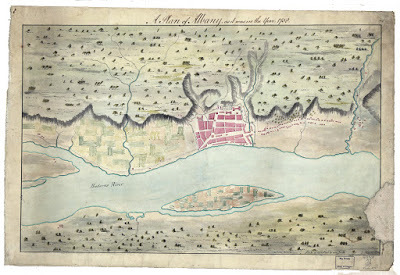 Albany, NY circa American Revolution
Albany, NY circa American Revolution
Schuyler spent the summer organizing for the invasion. At this point, Washington decided to dispatch Colonel Benedict Arnold to lead another invasion force to invade Quebec from Maine and join Schuyler's army outside Quebec City. Schuyler left most of the tedious work of military administration to Montgomery. Instead, he engaged in politics, his strong suit. Schuyler advocated for more men and supplies and negotiated to keep the Iroquois neutral during the campaign.
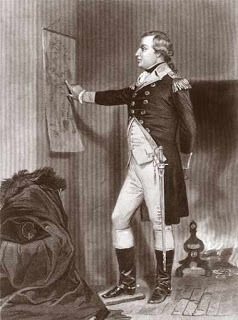 Colonel Benedict Arnold
Colonel Benedict Arnold
Meanwhile Montgomery, in receipt of intelligence that the British were preparing to put armed vessels on Lake Champlain, quickly sped north to confront the threat. Without seeking permission from Schuyler, he sailed up the lake with 1,200 men. Montgomery wrote a dispatch to Schuyler, explaining the situation. He knew the season for war was drawing to an end. Time was an issue, and it was not on the American side.
Next Edition: Richard Montgomery’s War

